
Introduction
Has there ever been a
bigger build up to any monitor release? Since the first prototype was shown off
at Computex in June 2016 (yes, over 2 years ago) there has been a massive
amount of
hype, anticipation and excitement about the Asus ROG Swift PG27UQ display.
There's been a bit of a dilemma for buyers in recent years. Do they prioritise
UltraHD (aka "4K") resolution for the sharpest possible image and highest level of detail, or
prioritise high refresh rates for the smoothest and fastest gaming experience.
Until now, it's been one or the other but the reason for the excitement with the
PG27UQ is because it will finally offer buyers the chance to have both. When the
prototype was displayed all that time ago, it was the first screen to be announced with an
Ultra HD 3840 x 2160 resolution and support for a high 144Hz refresh rate. Over
the last 2 years more and more information has emerged about this screen which
has only added to the excitement, and we
now finally have one with us for testing!
To summarise the key
features of the PG27UQ is tricky, as it really offers a huge range of specs and
options that to many people make up a dream monitor. The 27” sized Ultra HD
resolution panel is IPS-type in technology, using an AU Optronics AHVA panel for
great all round performance and all the benefits of IPS technology that are well
established in the market. This is a gaming screen, but it's not limited in
other areas like many TN Film gaming screens are. It offers support for refresh
rates up to 144Hz for super-smooth game play, high frame rate support and
improved motion clarity. To achieve this, it makes use of the latest DisplayPort
1.4 interface.
We are going to refer
to the resolution of this screen during this review as 4K in places. We know it's
technically called 'Ultra HD' but the term 4K is so widely used and frankly,
easier to keep referring to. Not only does it offer “4K” at
144Hz, it also features the latest NVIDIA G-sync HDR chip which supports the
variable refresh rate we know and love, and that will be extremely important
given the system demands of this resolution and refresh rate combination. This
new chip also offers top-end LCD
High Dynamic Range (HDR) capabilities thanks to a
384-zone Full Array Local Dimming (FALD) backlight system. This can offer
superior HDR experience compared with more limited edge-lit local dimming, and allows for
high-end specs like a 1000
cd/m2 peak brightness. A wide colour space for HDR is supported through an added Quantum Dot
film coating, offering coverage for the DCI-P3 colour space along with 10-bit
colour depth. Thanks to all these high end HDR features, the PG27UQ carries the
VESA DisplayHDR 1000 and
Ultra HD Premium certifications for HDR performance.
Why the wait?
2 years is a long time to go from prototype
to release, but this has been a very complicated and expensive screen to
produce. There have been delays while DisplayPort 1.4 was finalised and became
available from a graphics card point of view. That's only been a recent
development and only the very top end modern cards have DP 1.4 available. That
was needed to provide bandwidth to support the resolution and refresh rate, and
is well beyond the capability of the older DP 1.2 interface. Then there was the
FALD backlight which reportedly created all kinds of complications, especially
when trying to operate it with variable refresh rate technology from G-sync.
Early FALD backlights like that we saw and tested on the
Dell UP2718Q were very slow as well, and not suited to fast changing
content like gaming. That Dell screen was aimed at professional content creators
and HDR multimedia, but isn't really suitable for gaming in HDR due to that slow
FALD operation. A lot of work has gone in to making the FALD faster and better
for these gaming screens. Getting the whole thing working correctly will no
doubt have been a challenge, with BlurBusters.com reporting that they estimated
100x the amount of usual firmware-engineering hours went in to this screen. The
PG27UQ has appeared in some regions to purchase now. A few websites globally have looked at the screen already,
but our UK sample took a little longer to find its way to us. A recent firmware
update from Asus also delayed it a couple of weeks in July but it's here now,
and hopefully worth the wait!
The screen retails
for a very high price and so its target market is somewhat niche. We will put
the PG27UQ through all our normal tests to see how it performs to help you
consider whether it’s something you want to invest all that money in.

|
Check Pricing and Buy - Affiliate Links
|
|
Amazon
|
|
TFTCentral is a participant
in the Amazon Services LLC Associates Programme, an affiliate
advertising programme designed to provide a means for sites to earn
advertising fees by advertising and linking to Amazon.com, Amazon.co.uk,
Amazon.de, Amazon.ca and other Amazon stores worldwide. We also
participate in a similar scheme for Overclockers.co.uk. |

Specifications and
Features
The following table gives detailed
information about the specs of the screen as advertised:
|
Monitor
Specifications |
|
Size |
27" (68.4cm) |
Panel Coating |
Light AG coating |
|
Aspect
Ratio |
16:9 format, flat |
Interfaces |
1x
DisplayPort 1.4
1x HDMI 2.0
|
|
Resolution |
3840 x 2160 |
|
Pixel Pitch |
0.155mm (163 PPI) |
Design
colour |
Black bezel. 'Plasma copper' and 'Armor
Titanium' stand |
|
Response Time |
4ms G2G |
Ergonomics |
Tilt, 120mm height, swivel, rotate |
|
Static Contrast Ratio |
1000:1 SDR
50,000:1 HDR mode |
|
Dynamic Contrast Ratio |
n/a |
VESA Compatible |
Yes 100mm |
|
Brightness |
600 cd/m2 (typical)
1000 cd/m2 (peak HDR) |
Accessories |
DisplayPort, HDMI and USB cables. Power cable and brick |
|
Viewing Angles |
178 / 178 |
|
Panel Technology |
AU Optronics AHVA
(IPS-type) |
Weight |
with stand: 9.2 Kg |
|
Backlight Technology |
Direct LED with Quantum Dot
Enhancement Film (QDEF)
384-zone Full Array Local Dimming (FALD) |
Physical Dimensions |
(WxHxD) with stand
634 x 437 - 557 x 268 mm |
|
Colour Depth |
1.07b (8-bit+FRC) |
|
Refresh Rate |
120Hz native maximum
144Hz overclocked
(60Hz over HDMI) |
Special
Features |
3.5mm Headphone jack, NVIDIA
G-sync, 384-zone FALD for HDR, factory calibration report, Asus Aura Sync
technology, ROG Light Signal, ROG Light Signature, Ambient Light Sensor |
|
Colour
Gamut |
Extended gamut up to 97%
DCI-P3,
99% Adobe RGB
~125% sRGB |
The PG27UQ offers a limited range of
connectivity options given the use of an NVIDIA G-sync module. However, it does
offer the latest generation of DisplayPort 1.4 which allows support for the very
high bandwidth needed to power the screen at 3840 x 2160 @ 144Hz and with HDR.
There is also an HDMI 2.0b port for connection of external devices like games
consoles (60Hz maximum). Both ports support HDCP 2.2 and can handle HDR content,
so you can use HDR from your PC as well as compatible games consoles and Ultra
HD Blu-ray players.
There is an additional 2 port USB 3.0 hub, with the ports located
on the back of the screen and a headphone jack too. The screen has an external power supply and comes
packaged with the power cable and brick you need.
Below is a summary of the features and
connections of the screen:
|
Feature |
Yes / No |
Feature |
Yes / No |
|
Tilt adjust |
 |
DVI |
 |
|
Height adjust |
 |
HDMI |
 |
|
Swivel adjust |
 |
D-sub |
 |
|
Rotate adjust |
 |
DisplayPort |
 |
|
VESA compliant |
 |
Component |
 |
|
USB 2.0 Ports |
 |
Audio connection |
 |
|
USB 3.0 Ports |
 |
HDCP Support |
 |
|
Card Reader |
 |
MHL Support |
 |
|
Ambient Light Sensor |
 |
Integrated Speakers |
 |
|
Human Motion Sensor |
 |
PiP / PbP |
 |
|
Touch Screen |
 |
Blur Reduction Mode |
 |
|
Factory calibration |
 |
G-Sync |
 |
|
Hardware calibration |
 |
FreeSync |
 |
|
Uniformity correction |
 |
Wireless charging |
 |

Design and
Ergonomics
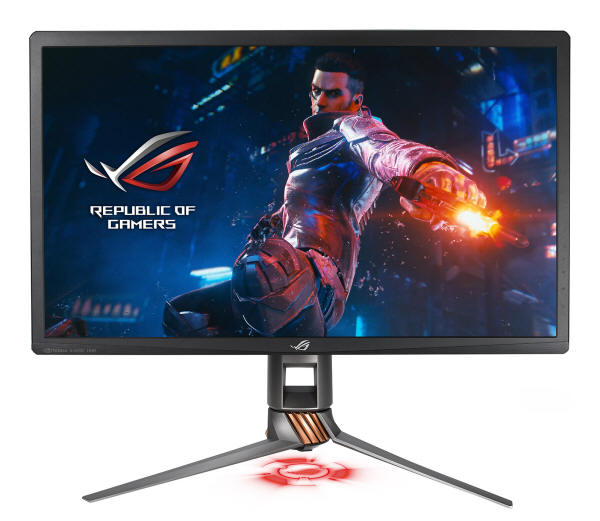
Above: front view of the screen. Click for larger version
The PG27UQ comes in a mixture of black,
"Armor Titanium" (dark grey) and "Plasma Copper" finishes. There is a
modestly sized matte black plastic bezel around all 4 sides of the screen
measuring 16mm along the sides, and 21mm along the top and bottom. There
is a small shiny silver ROG logo in the middle of the bottom bezel, a
subtle medium grey "NVIDIA G-Sync HDR" label in the bottom left hand
corner and subtle medium grey OSD control labels on the right hand edge of
the screen. A power LED is located on the bottom right hand edge of the
screen and glows white during normal operation, and amber in standby. This
is out of sight when using the screen from a typical viewing position.
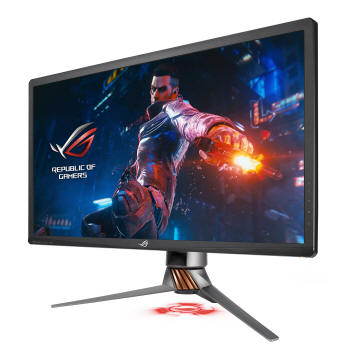
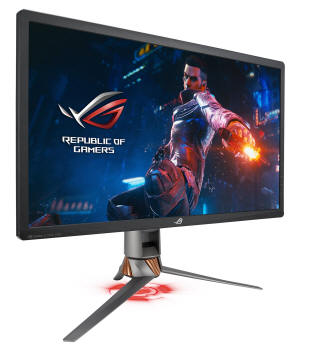
Above: front side views of the screen. Click for larger versions
The stand is predominantly a dark silver
"Armor Titanium" colour including a strong and sturdy metal 3-pronged
base. There are some "Plasma copper" coloured trim sections on the bottom
of the stand as you can see from the photos. There is a cable tidy hole in
the bottom part of the stand and the "ROG Light Signature" projects a red
logo on to the bottom of your desk. That can be turned on or off via the
'Light in Motion' option in the OSD menu.
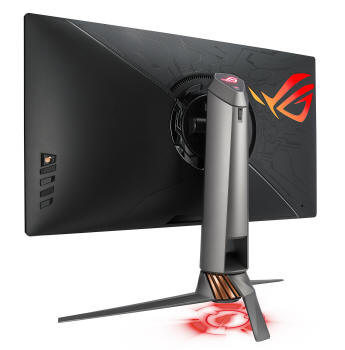
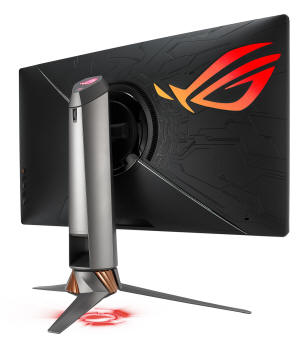
Above: rear side views of the screen. Click for larger versions
The back of the screen is encased in a matte
black plastic with some etched patterns on half of it. The OSD control
joystick and buttons are located on the back right hand side (when viewed
from the front). Also on the back of the screen is a larger ROG logo which
glows different colours if you activate it via the OSD menu. You can
either set it to a range of different colour modes, cycles or effects
using the 'Aura RGB' section, or you can sync this with your other 'Aura
Sync' devices like keyboards, mouse etc if you have them. When it's turned
off, that logo actually looks like a shiny silver section which makes it
look nice and eye-catching even with the lighting turned off.
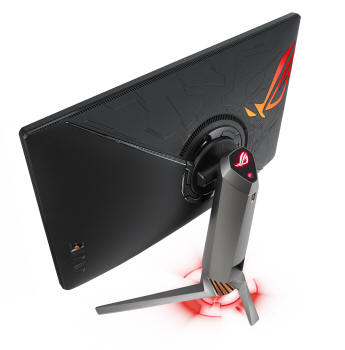
Above: rear angled view of the screen. Click for larger version
The stand attaches in to the middle of the
screen but can be removed to reveal a VESA 100mm mounting option if you
wish. All the lighting features are built in to the stand so you would
lose those of course if you removed the provided stand. In the top of the
stand is another smaller ROG logo which glows red if you have turned on
the 'Light in Motion' ROG Light Signature which projects from the bottom
of the stand. There is also a small red dot you can see on the top of the
stand in the image above. This is the 'ROG Light Signal' which projects a
red ROG logo on to the ceiling or wall behind the screen. You can change
the angle of this projection using a small scroll wheel on the back of the
stand.
All these lighting features are quite
fun, and we expect some users will want to have them turned on to enhance
the appearance of their gaming setup and to grab attention. You can of
course turn them off, but they do help to add a bit of a premium feel to
the screen through some added gadgets we felt.
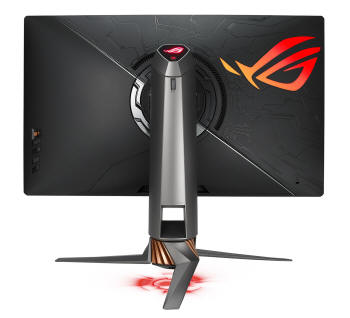
Above: rear view of the screen. Click for larger version
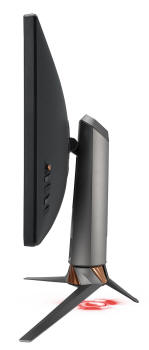
Above: side view of the screen. Click for larger version
The side view of the screen is not as thin as
some modern monitors and that is because of the extra size of the FALD backlight
unit. The stand is also quite chunky, but it does provide a very sturdy and
strong base for the screen which was pleasing.

There is a good range of ergonomic
adjustments offered by the stand. Tilt offers a wide range and is smooth to
move, if a little stiff to operate. There is a 120mm height adjustment which
smooth and easy to move. At the lowest setting the bottom edge of the screen is
60mm from the top of the desk, and 180mm when at maximum height extension. Side
to side swivel is provided and is smooth and a little stiff to use. Rotation to
portrait mode is also included and that is surprisingly smooth and easy to move.
It can often be quite clunky and stiff on some monitor stands. There is pretty
much no wobble at all from the screen when you re-position it, and the stand is
providing a very sturdy and stable base.
A summary of the ergonomic adjustments are
shown below:
|
Function |
Range |
Smoothness |
Ease of
Use |
|
Tilt |
Yes |
Smooth |
A little stiff |
|
Height |
120mm |
Smooth |
Easy |
|
Swivel |
Yes |
Smooth |
A little stiff |
|
Rotate |
Yes |
Smooth |
Easy |
|
Overall |
Very good set of adjustments
and all easy to move. Screen remains stable with no wobble. |
The OSD control joystick and buttons are
located on the back right hand side (when viewed from the front). There is
quick access to the GamePlus extra options like the FPS counter and crosshair
from one button, and access to the GameVisual preset mode menu from another.
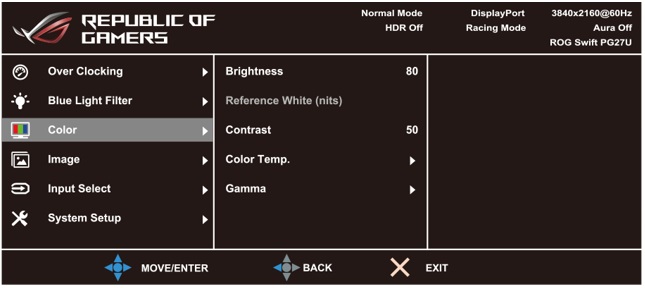
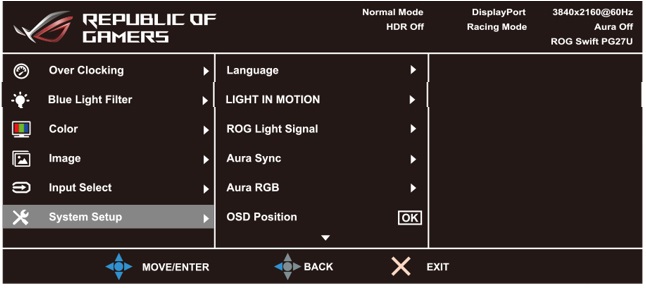
The joystick can then be used to control
the rest of the menu quickly and easily. We found this worked very well and
was fast and intuitive to navigate through the various options. We saw no
issues with the quality of the joystick control on our sample, it was not
flimsy and didn't get stuck at all which was good. There was a wide range of
options available in the menu as well, including a good range of preset modes,
colour controls, image boosting options and controls for all the extra
lighting and added features.

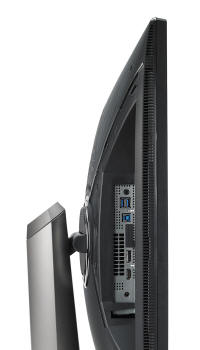
Above: On the right, connection options on the back of the screen (when
rotated on stand). Click for larger version
The back of the screen features the
connections. There is HDMI 2.0, DisplayPort 1.4, USB upstream and 2x USB 3.0
downstream and 1x headphone jack connections provided.
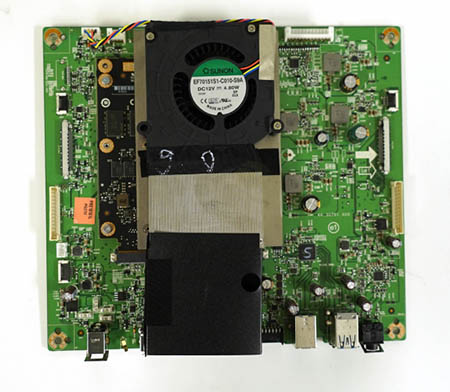
Above:
dismantled view of the
internal cooling fan.
Photo courtesy of
PcPer.com who did a nice tear-down of the screen
One thing
we should mention is that there is a small internal fan in this screen which
is needed to ensure it stays cool enough, especially during high refresh HDR
gaming. It helps keep the G-sync module and FALD backlight cooler. We have
seen small fans used in screens before, for instance the RGB backlit
Samsung XL20 from 2007 needed one as well because of the advanced
backlight unit. You can hear the fan on the PG27UQ if you listen closely for
it, and if you have an otherwise silent PC setup you will notice it. It is
quiet and certainly we found that it was not audible beyond our normal couple
of PC fans which are fairly quiet. We would have course preferred it without
the fan, and it's likely to bother silent PC enthusiasts but it wasn't a major
issue we felt.

Power Consumption
In terms of power consumption the
manufacturer lists a typical usage of 180W with HDR on, but don't list any other
specs.
We carried out our normal tests to establish its power consumption ourselves in
a few states.
|
 |
|
State and Brightness Setting |
Manufacturer Spec (W) |
Measured Power Usage (W) |
|
Default (60%) |
- |
69.3 |
|
Calibrated (18%) |
- |
45.1 |
|
Maximum Brightness
(100%) |
- |
90.5 |
|
Minimum Brightness
(0%) |
- |
35.5 |
|
Standby |
- |
1.4 |
|
Out of the box the screen used 69.3W at the
default 60% brightness setting. Once calibrated the screen reached
45.1W
consumption, and in standby it used only 1.4W. We have plotted these results
below compared with other screens we have tested. The consumption (comparing the
calibrated states) is pretty similar to the other FALD display we've tested, the
Dell UP2718Q which is probably to be expected. These FALD backlit displays use
quite a lot more power than traditional W-LED backlight models, and so the
PG27UQ uses a similar amount of power in fact to a much larger 34 - 35" screen.


Panel and Backlighting
|
Panel Manufacturer |
AU Optronics |
Colour Palette |
1.07 billion |
|
Panel Technology |
AHVA (IPS-type) |
Colour Depth |
8-bit + FRC |
|
Panel Module |
M270QAN02.2 |
Colour space |
Extended gamut |
|
Backlighting Type |
Direct LED with Quantum
Dot coating. 384-zone FALD for HDR |
Colour space coverage (%) |
Up to 97% DCI-P3 quoted
99% Adobe RGB
~125% sRGB |
Panel Part and Colour Depth
The Asus ROG Swift PG27UQ features an
AU Optronics M270QAN02.2 AHVA (IPS-type) technology panel which is capable of producing
1.07 billion colours. This is achieved through a 8-bit+FRC colour depth as
detailed in the manufacturers specification. Some people may complain that the
panel is not a native full 10-bit panel, but in reality you are going to be very
hard pressed to see any real difference in practice between a good 8-bit+FRC
panel and a true 10-bit panel. Even more so when you consider whether you're
going to actually be able to use the 10-bit colour depth in real use.
This screen is aimed at gaming of course, and
NVIDIA gaming graphics card users. There is a bit of confusion online about
whether these consumer grade graphics cards can truly support 10-bit or not so
we will try and clear that up a bit here. NVIDIA Geforce graphics cards have
been able to support 10-bit colour depth output actually since the 200 series
GPU's
as confirmed by NVIDIA themselves. The important thing to note though is
that for Windows users this is for Direct X applications like games only, and
does not apply for professional applications like Adobe Premiere Pro or Adobe
Photoshop. So you can use an NVIDIA Geforce consumer-grade graphics card for
10-bit colour depth in gaming, as long as it is a game which support that colour
depth. This is of course particularly relevant here for HDR gaming where a
10-bit colour depth is widely available.
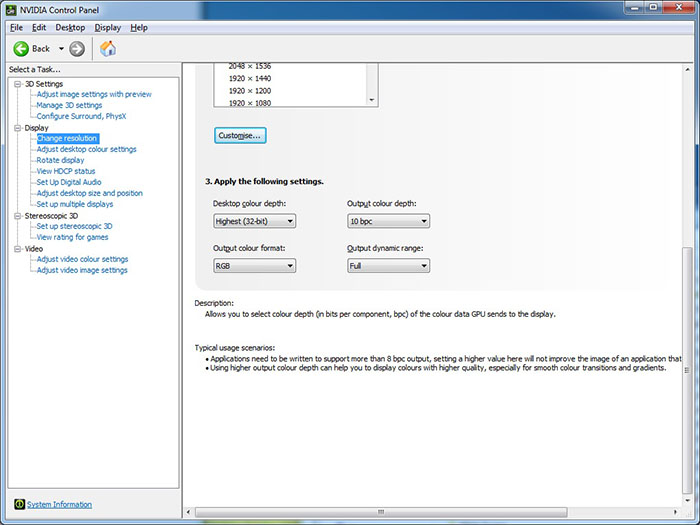
Above:
10-bit colour depth selection in the NVIDIA control panel
However, while the NVIDIA Geforce cards can
support 10-bit for DirectX, this is not supported for the aforementioned
professional applications like Photoshop. Those programs use OpenGL 10-bit
colour buffers which are not supported from the NVIDIA Geforce cards. You would
need an NVIDIA Quadro professional grade card for 10-bit support in those
professional applications. Achieving 10-bit colour depth can be quite tricky, as
it requires an end to end 10-bit workflow including software/game > relevant
graphics card > supported drivers > supported operating system > supported
display interface > supported display. The good news is that the PG27UQ will
support 10-bit content and given this is firmly aimed at gamers, that will mean
most will use that support from their NVIDIA Geforce card when it comes to HDR
gaming, but not be able to make use of it for any professional applications.
Just make sure you have all the relevant software and operating systems in place
if you want to use it.
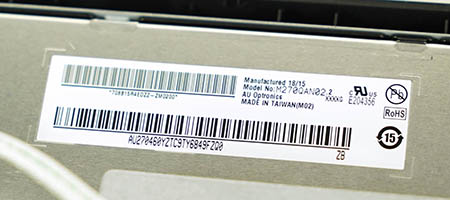
The panel part is confirmed when dismantling
the screen as shown above. Photo courtesy of
PcPer.com who did a nice tear-down of the screen.
Screen
Coating
The
screen coating is a light anti-glare (AG) offering. It isn't a semi-glossy
coating, but it is light as seen on other modern IPS type panels. Thankfully it
isn't a heavily grainy coating like some old IPS panels feature and is also
lighter than modern TN Film panel coating. It retains its anti-glare properties
to avoid too many unwanted reflections of a full glossy coating, but does not
produce too grainy or dirty an image that some thicker AG coatings can.
There are no visible cross hatching patterns on the panel coating.
Backlight Type and Colour Gamut
The screen uses a Direct LED backlight
unit with an added Quantum Dot Enhancement Film (QDEF)
coating to extended the colour space and gamut. This allows for a high coverage
of the DCI-P3 colour space which is the reference used for HDR content and
displays and something you will see more commonly talked about with TV's and
monitors in the future. This screen offers "up to 97% coverage" of the DCI-P3
colour space according to the specs, something that we will verify and test in a
moment. This also allows for 99% coverage of the Adobe RGB colour space, and
corresponds to around 125% of the commonly used sRGB reference.
Basically the screen is capable of producing
a wide range of colours than most monitors, which are normally based around
providing coverage of the common sRGB colour space. With the Quantum Dot coating
film, the PG27UQ can cover beyond that, producing more bright and
vivid colours to enhance gaming, multimedia and HDR content. High coverage of
the DCI-P3 colour space is a requirement if a display is to conform to common
HDR standard such as the Ultra HD Premium certification (used in the TV market
predominantly) and the new VESA DisplayHDR certifications.
If you want to read more about colour spaces and gamut then please have
a read of our
detailed article.
Backlight
Dimming and Flicker
We tested the screen to establish the methods
used to control backlight dimming. Our in depth article talks in more details
about a previously very common method used for this which is called
Pulse Width Modulation (PWM). This in itself gives cause for concern to some
users who have experienced eye strain, headaches and other symptoms as a result
of the flickering backlight caused by this technology. We use a photosensor +
oscilloscope system to measure backlight dimming control with a high level of
accuracy and ease. These tests allow us to establish
1) Whether PWM is being used to control the
backlight
2) The frequency and other characteristics at which this operates, if it is used
3) Whether a flicker may be introduced or potentially noticeable at certain
settings
If PWM is used for backlight dimming, the
higher the frequency, the less likely you are to see artefacts and flicker. The
duty cycle (the time for which the backlight is on) is also important and the
shorter the duty cycle, the more potential there is that you may see flicker.
The other factor which can influence flicker is the amplitude of the PWM,
measuring the difference in brightness output between the 'on' and 'off' states.
Please remember that not every user would notice a flicker from a backlight
using PWM, but it is something to be wary of. It is also a hard thing to
quantify as it is very subjective when talking about whether a user may or may
not experience the side effects.
100%
50%
0%
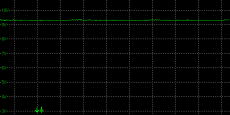
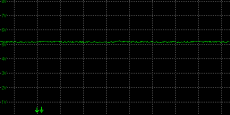
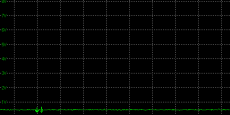
Above scale
= 1 horizontal grid = 5ms
At all brightness settings a constant
Direct Current (DC) voltage is applied to the backlight, and the screen is
free from the obvious off/on switching of any PWM dimming method. As a result,
the screen is flicker free as advertised.
|
Pulse
Width Modulation Used |
No |
|
Cycling
Frequency |
n/a |
|
Possible Flicker at |
|
|
100% Brightness |
No |
|
50% Brightness |
No |
|
0% Brightness |
No |

Brightness
and Contrast
We wanted to measure the luminance range
available from the backlight as well as see how much variance there
was in the screens contrast as we adjusted the monitor setting for brightness.
In theory, brightness and contrast are two independent parameters, and good
contrast is a requirement regardless of the brightness adjustment.
Unfortunately, such is not always the case in practice. We recorded the
screens luminance and black depth at various OSD brightness settings, and
calculated the contrast ratio from there. Graphics card settings were left at
default with no ICC profile or calibration active. Tests were made using an
X-rite i1 Display Pro colorimeter. It should be noted that we used the
BasICColor calibration software here to record these, and so luminance at
default settings may vary a little from the LaCie Blue Eye Pro report.
|
OSD
Brightness |
Luminance
(cd/m2) |
Black Point (cd/m2) |
Contrast Ratio
( x:1) |
|
100 |
532.29 |
0.49 |
1086 |
|
90 |
501.83 |
0.47 |
1068 |
|
80 |
446.69 |
0.41 |
1089 |
|
70 |
397.29 |
0.37 |
1074 |
|
60 |
346.94 |
0.33 |
1051 |
|
50 |
292.13 |
0.27 |
1082 |
|
40 |
236.34 |
0.22 |
1074 |
|
30 |
185.85 |
0.17 |
1093 |
|
20 |
129.76 |
0.12 |
1081 |
|
10 |
73.03 |
0.07 |
1043 |
|
0 |
24.01 |
0.02 |
1200 |
|
Total Luminance Adjustment Range
(cd/m2) |
508.28 |
Brightness OSD setting
controls backlight? |
 |
|
Total Black Point Adjustment Range (cd/m2) |
0.47 |
|
Average Static Contrast Ratio |
1086:1 |
PWM Free? |
 |
|
Recommended OSD setting for 120 cd/m2 |
19 |
At the top end the maximum luminance reached
a very high 532
cd/m2
which was extremely bright, although a little less than the specified maximum brightness of
600 cd/m2
from the manufacturer for SDR content. It is the FALD backlight that allows for this improved
brightness range. There was an excellent 508 cd/m2 adjustment range in
total, so at the minimum setting you could reach down to a very low luminance of
24 cd/m2. This should be more low enough for most people including
those wanting to work in darkened room conditions with low ambient light. A
setting of 19 in the OSD
menu should return you a luminance of around 120 cd/m2 at default
settings.
It should be noted
that the brightness regulation is controlled without the need for
Pulse Width Modulation for all brightness settings so the screen is flicker
free.
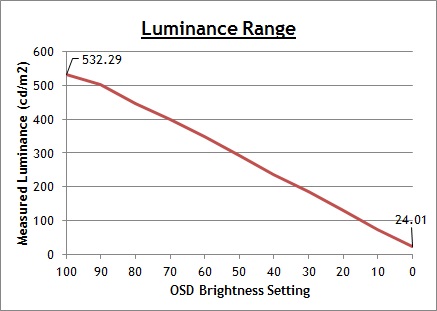
We have plotted the
luminance trend on the graph above. The screen behaves as it should in this
regard, with a reduction in the luminance output of the screen controlled by the
reduction in the OSD brightness setting. This is almost a linear relationship
as you can see, with a slightly less steep adjustment curve between 100 and 90%
brightness settings. We were impressed by the wide range offered here.
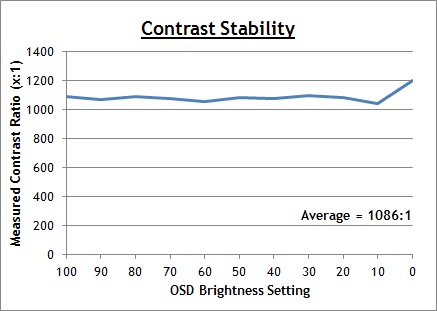
The average contrast ratio of the screen
was measured at 1086:1 which was good for an IPS-type panel. This remains pretty
stable across the brightness adjustment range, with a small increase at the
lowest settings between 10 and 0%.
SDR Contrast Ratio with FALD Active (updated 6/8/18)
Note that the figures above are for the
static contrast ratio without the 'variable backlight' (Full Array Local
Dimming) turned on. That can operate in both SDR and HDR content and can
significantly increase the active perceived contrast ratio of the screen. Dark
areas are dimmed, and brighter areas are turned up. With a screen calibrated to
around 120
cd/m2
and FALD active in SDR mode we measured a black depth of 0.02 cd/m2
and therefore an active contrast ratio of ~6000:1. This was for where a small
white sample on the screen was compared with a measurement of a black part of
the screen furthest away.
Actually you can
achieve the same black point of 0.02 cd/m2
even when you increase the brightness up to the maximum 100% setting (533 cd/m2
luminance peak), and therefore you can achieve active contrast ratios of around
26,650:1 even in SDR mode. The FALD is capable of producing some very strong
active contrast ratios even in SDR content, and you are only really limited by
the maximum luminance in terms of how high that contrast ratio will go.
HDR contrast will be
looked at later on in the review.

Testing
Methodology
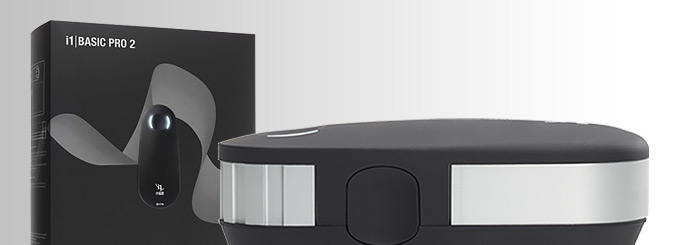
An important thing to consider for most users
is how a screen will perform out of the box and with some basic manual
adjustments. Since most users won't have access to hardware colorimeter tools,
it is important to understand how the screen is going to perform in terms of
colour accuracy for the average user.
We restored our graphics card to default
settings and disabled any previously active ICC profiles and gamma corrections.
The screen was tested at default factory settings using our new
X-rite i1 Pro 2
Spectrophotometer combined with
LaCie's Blue Eye Pro software suite. An X-rite i1 Display Pro colorimeter
was also used to verify the black point and contrast ratio since the i1 Pro 2
spectrophotometer is less reliable at the darker end.
Targets for these tests are as follows:
-
CIE Diagram - validates the colour
space covered by the monitors backlighting in a 2D view, with the black triangle
representing the displays gamut, and other reference colour spaces shown for
comparison
-
Gamma - we aim for 2.2 which is the
default for computer monitors
-
Colour temperature / white point - we
aim for 6500k which is the temperature of daylight
-
Luminance - we aim for 120
cd/m2,
which is the recommended luminance for LCD monitors in normal lighting
conditions
-
Black depth - we
aim for as low as possible to maximise shadow detail and to offer us the best
contrast ratio
-
Contrast ratio -
we aim for as high as possible. Any dynamic contrast ratio controls are turned
off here if present
-
dE average / maximum
- as low as possible.
If DeltaE >3, the color displayed is significantly different from the
theoretical one, meaning that the difference will be perceptible to the viewer.
If DeltaE <2, LaCie considers the calibration a success; there remains a slight
difference, but it is barely undetectable. If DeltaE < 1, the color fidelity is
excellent.

Default Setup and
Factory Calibration
The PG27UQ carries a factory calibration which is applicable in the default
state of the monitor. This applies in the 'Racing mode' preset and is factory
calibrated to achieve accurate grey-scale tracking and a a delta E of <3. It
should be noted that the monitor is by default set to produce an sRGB colour
space and is set to operate in normal SDR (Standard Dynamic Range) mode.
Enabling wide gamut can be done via the OSD
menu and we will look at those a bit more in a moment.
The screen comes with a specific factory
calibration report for the unit as shown by the example which came with ours:
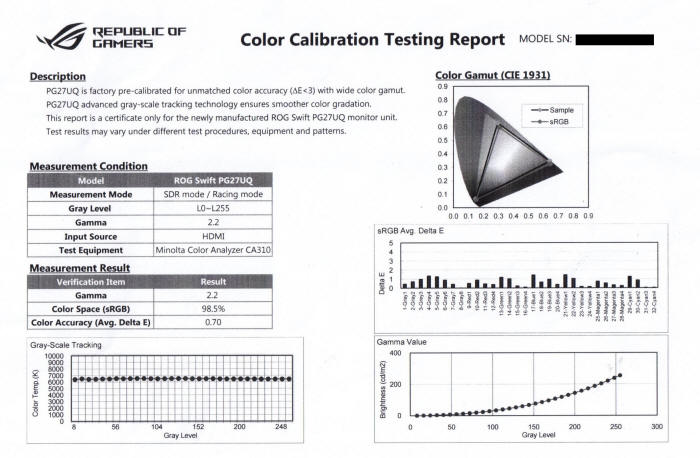
Above: factory calibration report. Click for larger version
Default settings of the screen were as follows:
Asus
ROG Swift PG27UQ
Default Settings
(Factory Calibration)
 

|

 |
|
Monitor
OSD Default Settings |
|
|
GameVisual |
Racing mode |
|
Brightness |
60 |
|
Contrast |
50 |
|
Color Temp |
Normal |
|
Gamma |
2.2 |
|
RGB |
n/a |
|
Luminance
Measurements |
|
|
luminance (cd/m2) |
355 |
|
Black Point (cd/m2) |
0.34 |
|
Contrast Ratio |
1051:1 |
|
Colour
Space Measurements |
|
|
sRGB coverage |
97.5% |
|
DCI-P3 coverage |
71.9% |
|
Rec.2020 coverage |
51.6% |
|
Before we started, we turned off the
'variable backlight' option within the OSD menu. That controls the FALD
backlight and can be used in SDR and HDR modes to dim and brighten different
areas of the screen depending on the content to enhance the contrast and dynamic
range. We wanted to test the screen out of the box without this happening,
particularly so we could accurately measure the luminance and static contrast
ratio of the panel.
Initially out of the box the screen was set
with the GameVisual preset mode set to 'Racing mode' and the other default
settings shown above. The screen felt very bright to the naked eye, even though
the brightness control was set at a fairly modest 60% - a lot of screens come
set at 100%. Colour balance felt very good and you could tell that out of the
box the screen was operating with a standard sRGB colour space.
We went ahead and measured the default state
with the i1 Pro 2. The
CIE diagram
on the left of the image confirms that the monitors colour gamut (black
triangle) matches the sRGB colour space reference
(orange triangle) closely. We measured using ChromaPure software a 97.5% sRGB gamut
coverage which corresponds to 71.9% of the DCI-P3 reference and 51.6% of the
Rec.2020 reference. This was pretty comparable to Asus' factory measurements
recording in the calibration report of 98.5% sRGB. Remember, the screen is set
to operate in an sRGB emulation mode out of the box while in SDR settings, and
so you are not seeing the full range of colours possible from the backlight and
Quantum Dot coating. It's very easy to switch up to the wide gamut mode in the
OSD menu using the 'Display SDR input' option, switching that from sRGB to wide
gamut.
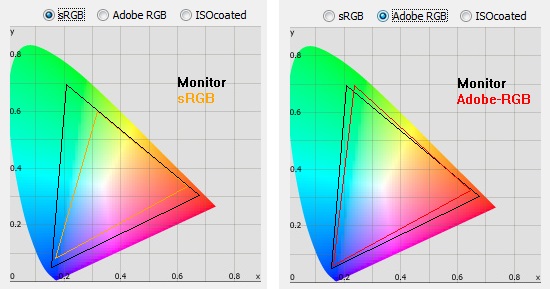
Above: colour space coverage when switched to the 'wide gamut' mode in
the OSD menu
|
Colour
Space Measurements in wide gamut mode (SDR) |
|
sRGB coverage |
149.6% |
|
DCI-P3 coverage |
110.3% |
|
Rec.2020 coverage |
79.1% |
If you switch to this wide gamut mode you can
see an immediate and noticeable difference to the colours. They look far more
bright and vivid, as is typical for a screen based on a wide gamut backlight.
The CIE diagrams above show that the monitors colour space now stretches a
considerable way beyond the sRGB reference space, and quite closely matches the
Adobe RGB reference. We measured a coverage of 149.6% sRGB, 110.3% DCI-P3, 79.1%
Rec. 2020 in this wide gamut mode which was actually quite a bit wider than even
the advertised spec. The gamma and white point performance remain the same
regardless of whether you switch to sRGB or wide gamut mode.
Default gamma of the screen was recorded at 2.2
average, with a very small 2% deviance from the target which was great news. The
gamma looked to be a little off in the darker grey shades. White point was measured
at a pretty accurate 6315k being only a small 3% out from our 6500k target.
Luminance was recorded at a very bright 355
cd/m2
which is far too high for prolonged general use, you will need to turn that
down. The screen was set at a default 60% brightness in the OSD menu but that
is easy to change of course to reach a more comfortable setting without
impacting any other aspect of the setup. The black depth was 0.34 cd/m2
at this default brightness setting, giving us a good static contrast ratio for
an IPS-type panel of 1051:1. We have seen some IPS panels reach up to around 1200
- 1400:1 recently but somewhere around 1000:1 is still decent for this technology.
Remember that the active contrast ratio will be significantly enhanced if you
operate the 'variable backlight' FALD in both normal SDR mode and when using HDR
mode and content. We will test that more later on.
Colour accuracy was really excellent out of the box
with an average dE of 0.4 and a maximum of 1.3 - to the point where we let out
an audible "wow" when we first saw the results generated. Testing the screen
with colour gradients showed smooth gradients with only very minor gradation evident
in the darker tones. There was no sign of any colour banding which was good
news.
Overall this was a really good factory
calibration with accurate gamma and white point, very good colour accuracy and
reliable emulation of the sRGB colour space, with the ability to easily switch
to the wide gamut mode if you want. We weren't sure how this was going to work
before testing the screen in relation to the colour space and Quantum Dot film
coating, but it was great to see the availability of an sRGB mode for those who
want to use the screen for other things beyond gaming and multimedia. Sure, you
might want the boosted, more vivid colours of the wide gamut capability for those
uses, but unless you're specifically working with wide gamut content in a colour
managed workflow, you will probably want to use the sRGB mode for photo, colour
work and more general office uses.
Color Temp Setting Measurements
|
Colour
Temp OSD setting |
White
point measurement |
|
Normal |
6315k |
|
Warm |
5201k |
|
Cool |
6962k |
|
User |
6315k |
We carried out a test of the various Color
Temp modes as well out of interest and the results as shown above. The
normal mode was closest to our 6500k target which was good news. The other modes
behaved as they should, offer various options for a cooler or warmer setup. The
User mode was the same as the normal mode by default, but gives you access to
the RGB channels for customised calibration.
Gamma Setting Measurements
|
Gamma
OSD setting |
Measured
average gamma |
|
1.8 |
1.8 |
|
2.0 |
2.0 |
|
2.2 |
2.2 |
|
2.4 |
2.4 |
|
2.6 |
2.6 |
We also carried out measurement of each of
the gamma modes available via the OSD menu. Some of the GameVisual preset modes
have different default settings for gamma as well keep in mind, and you can
always customise some of the presets to your liking. All of the modes showed a
really reliable average gamma in keeping with the desired target which was
excellent. You can have faith in the setting to deliver the gamma curve it says
it will.

Calibration
We used the
X-rite i1 Pro 2
Spectrophotometer combined with the LaCie Blue Eye Pro software package to
achieve these results and reports. An X-rite i1 Display Pro colorimeter was used
to validate the black depth and contrast ratios due to lower end limitations of
the i1 Pro device.
Asus
ROG Swift PG27UQ
Calibrated
Settings



|
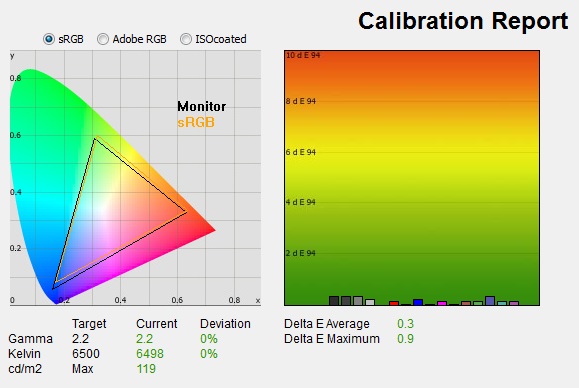
 |
|
Monitor
OSD Default Settings |
|
|
GameVisual |
Racing mode |
|
Brightness |
18 |
|
Contrast |
50 |
|
Color Temp |
User |
|
Gamma |
2.2 |
|
RGB |
96, 98, 100 |
|
Luminance
Measurements |
|
|
luminance (cd/m2) |
119 |
|
Black Point (cd/m2) |
0.11 |
|
Contrast Ratio |
1071:1 |
|
Colour
Space Measurements |
|
|
sRGB coverage |
97.5% |
|
DCI-P3 coverage |
71.9% |
|
Rec.2020 coverage |
51.6% |
|
We changed here to the user mode in the
colour temp menu
which gives you access to the RGB channel adjustments. We stuck with the default
2.2 gamma mode which we knew to be very close to the target out of the box,
thanks to the excellent factory calibration. Settings were
adjusted as shown in the table above, as guided during the calibration process
and measurements.
These OSD changes allowed us to obtain an optimal hardware starting point and
setup before software level changes would be made at the graphics card level. We
left the LaCie software to calibrate to "max" brightness which would just
retain the luminance of whatever brightness we'd set the screen to, and would
not in any way try and alter the luminance at the graphics card level, which can
reduce contrast ratio. These adjustments before profiling the screen would help
preserve tonal values and limit banding issues. After this we let the software
carry out the LUT adjustments and create an
ICC profile.
Average gamma was measured at 2.2 average (0%
deviance) which fixed the very small 2% deviance we'd seen out of the box at default
settings. The accurate white point of the default mode was maintained here, but
we corrected the small 3% deviance and
we now measured a colour temperature of 6498k, spot on with our target
basically. Luminance had been improved thanks to the adjustment to the
brightness control and was now being measured at a far more comfortable 119
cd/m2.
This left us a black depth of 0.11 cd/m2 and a static contrast ratio
of 1071:1 which was good for IPS panel technology. Colour accuracy of the resulting profile was excellent too, with dE
average of 0.3 and maximum of 0.9. LaCie would consider colour fidelity to be
excellent.
Testing the screen with various colour
gradients showed very smooth transitions with only some very minor gradation in darker
tones.
You can use our settings
and try our calibrated ICC profile if you wish, which are available in
our ICC profile database. Keep in mind that results will vary from one
screen to another and from one computer / graphics card to another.

Calibration
Performance Comparisons
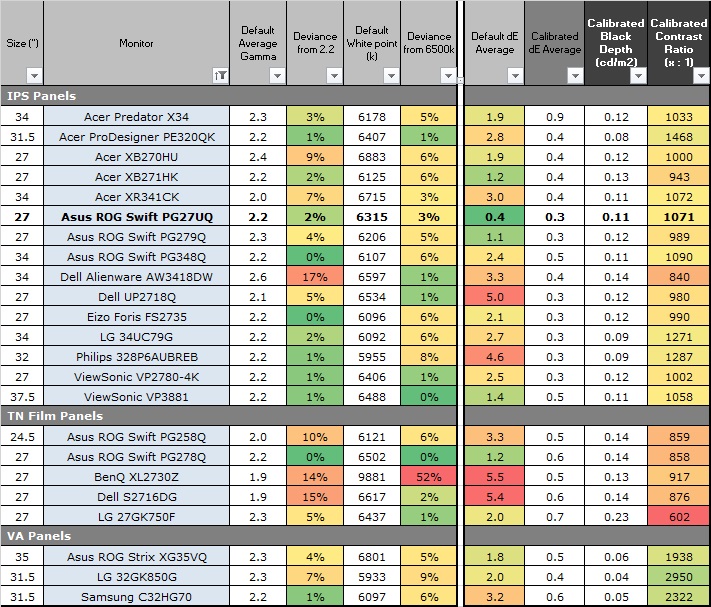
The comparisons made in this section try to
give you a better view of how each screen performs, particularly out of the box
which is what is going to matter to most consumers. We have divided the table up
by panel technology as well to make it easier to compare similar models. When
comparing the default factory settings for each monitor it is important to take
into account several measurement areas - gamma, white point and colour accuracy.
There's no point having a low dE colour accuracy figure if the gamma curve is
way off for instance. A good factory calibration requires all 3 to be well set
up. We have deliberately not included luminance in this comparison since this is
normally far too high by default on every screen. However, that is very easily
controlled through the brightness setting (on most screens) and should not
impact the other areas being measured anyway. It is easy enough to obtain a
suitable luminance for your working conditions and individual preferences, but a
reliable factory setup in gamma, white point and colour accuracy is important
and some (gamma especially) are not as easy to change accurately without a
calibration tool.
From these comparisons we can also compare
the calibrated colour accuracy, black depth and contrast ratio. After a
calibration the gamma, white point and luminance should all be at their desired
targets.
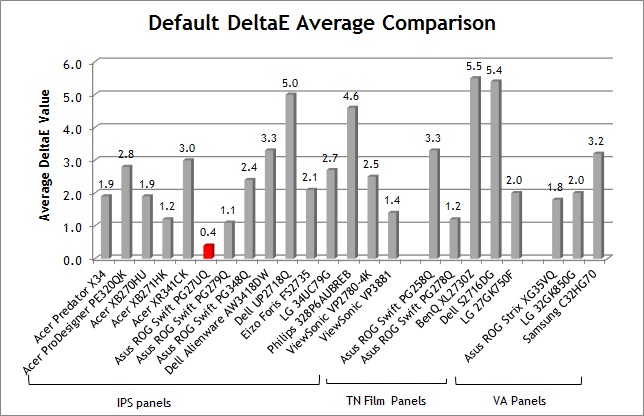
The PG27UQ carries an excellent factory
calibration that we were really impressed with, especially considering this is
primarily a gaming screen and those are often set up for less "accurate"
targets. We had a good gamma curve and white point with only a couple of %
deviance from the targets, and an excellent dE of only 0.4 out of the box. No
complaints about the default setup here.
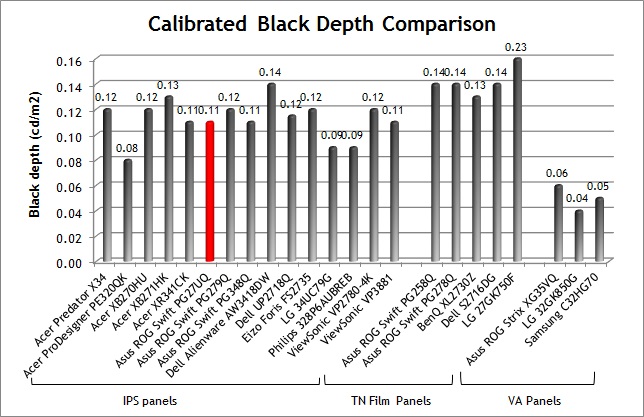
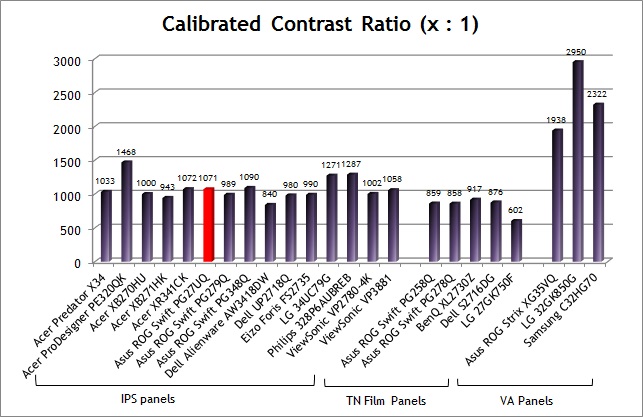
When it comes to black depth and contrast
ratio the screen performed well for an IPS-type panel, with a calibrated
contrast ratio of 1071:1. We have seen some modern IPS panels start to reach up
to 1200 - 1400:1 or so as you can see above, but somewhere around 1000:1 is
still respectable for this technology, with some others dipping under that down
to the 800 - 900:1 range. You can see that IPS cannot compete with VA technology
panels though which typically reach up to 2000:1 or more.
Note that this is the static contrast ratio
without the 'variable backlight' (Full Array Local Dimming) turned on. That can
operate in both SDR and HDR content and can significantly increase the active
contrast ratio of the screen. Dark areas are dimmed, and brighter areas are
turned up. With a screen calibrated to around 120
cd/m2
and FALD active in SDR mode we measured a black depth of 0.02 cd/m2
and therefore an active contrast ratio of ~6000:1. This was for where a small
white sample on the screen was compared with a measurement of a black part of
the screen furthest away. Actually you can achieve the same black point of 0.02
cd/m2
even when you increase the brightness up to the maximum 100% setting (533 cd/m2
luminance), and therefore you can achieve active contrast ratios of around
26,650:1 even in SDR mode. HDR contrast will be looked at later on in the
review.
|
Check Pricing and Buy - Affiliate Links
|
|
Amazon
|
|
TFTCentral is a participant
in the Amazon Services LLC Associates Programme, an affiliate
advertising programme designed to provide a means for sites to earn
advertising fees by advertising and linking to Amazon.com, Amazon.co.uk,
Amazon.de, Amazon.ca and other Amazon stores worldwide. We also
participate in a similar scheme for Overclockers.co.uk. |

Viewing Angles
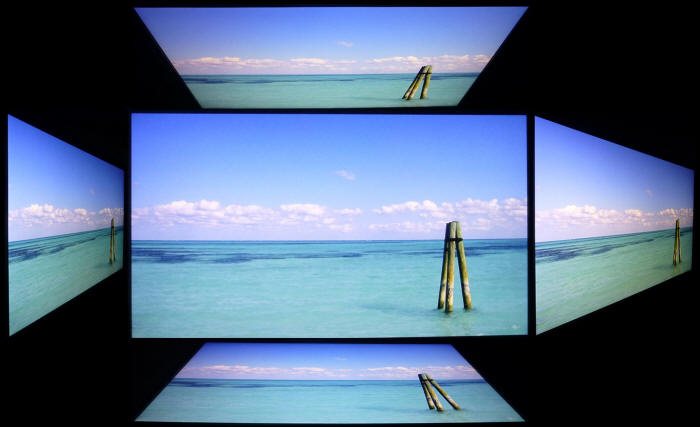
Above: Viewing angles shown from front and side, and from above and below.
Click for larger image
Viewing angles of the screen were very good
as you would expect from an IPS-type panel. Horizontally there was very little
colour tone shift until wide angles past about 45°. A slight darkening of the
image occurred horizontally from wider angles as you can see above as the
contrast shifted slighting. Contrast shifts were slightly more noticeable in the
vertical field but overall they were very good. The screen offered the wide
viewing angles of IPS technology and was free from the restrictive fields of
view of TN Film panels, especially in the vertical plane. It was also free of
the off-centre contrast shift you see from VA panels and a lot of the quite
obvious gamma and colour tone shift you see from some of the modern VA panel
type offerings.
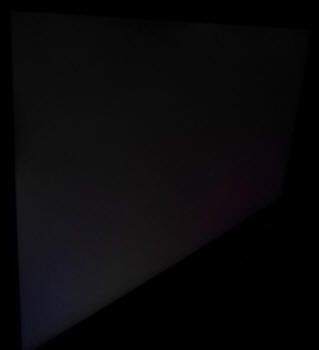
Above: View
of an all black screen in a dark room from the side. Click for larger version
On a black image we were very pleased to
learn that this was a low-glow panel, and did not show the usual
pale/white/purple off-angle glow on dark content that most IPS panels can suffer
from. Here, the black remained fairly stable, with only low amounts of glow
visible. The image above was taken with the FALD variable backlight turned off.
If you turn that on, it will operate even for SDR content and on an all-black
screen and on darker content it makes a significant improvement again. Blacks
become darker, and any low amount of IPS-glow is reduced as a result. You can
compare the performance here to the AU Optronics IPS-type panel used in the
earlier
Asus ROG Swift PG279Q (144Hz IPS-type, 1440p resolution) which shows a far
more noticeable white glow which is pretty standard for most IPS-type panels.

Panel Uniformity
We wanted to
test here how uniform the brightness was across the screen, as well as identify
any leakage from the backlight in dark lighting conditions. Measurements of the
luminance were taken at 35 points across the panel on a pure white background.
The measurements for luminance were taken using BasICColor's calibration
software package, combined with an X-rite i1 Display Pro colorimeter with a
central point on the screen calibrated to 120 cd/m2. The below
uniformity diagram shows the difference, as a percentage, between the
measurement recorded at each point on the screen, as compared with the central
reference point.
It is worth
noting that panel uniformity can vary from one screen to another, and can depend
on manufacturing lines, screen transport and other local factors. This is only a
guide of the uniformity of the sample screen we have for review.

Uniformity of Luminance
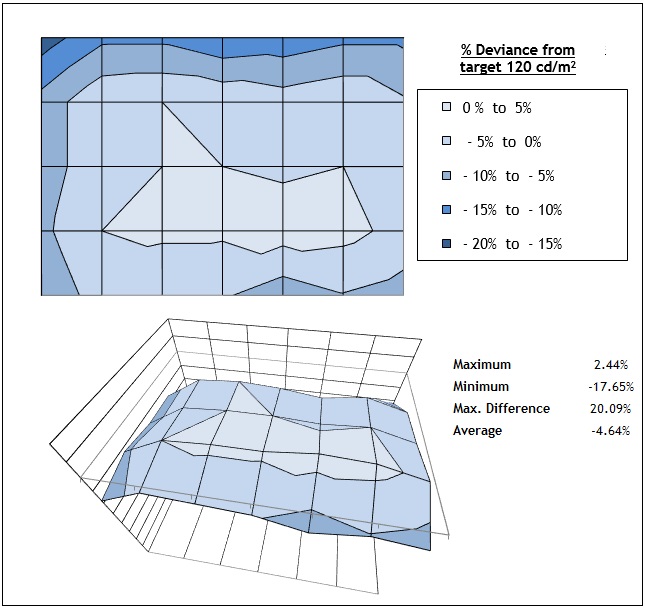
The
PG27UQ had a fairly good uniformity overall. The upper portion of the screen
was a little darker than the rest where it dropped down to 102 cd/m2
in the most extreme example (-17.65% deviance). Apart from this upper
region, the rest of the screen was all within an acceptable 10% deviance
from the centrally calibrated point which was good news. In total, 80% of
the screen was within this deviance threshold.

Backlight Leakage
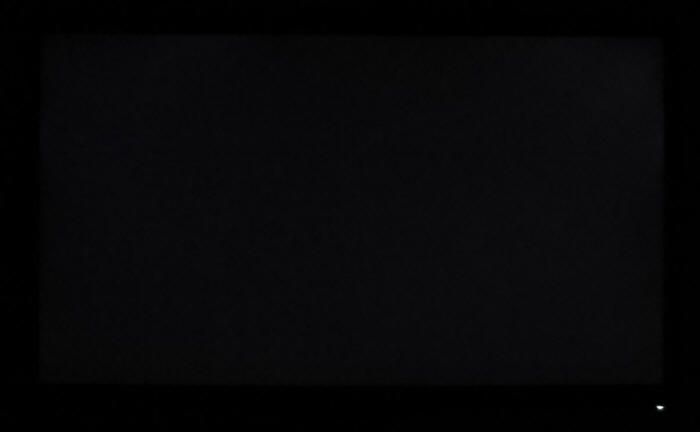
Above: All
black screen in a darkened room. Click for larger version
We also tested the screen with an all black
image and in a darkened room. A camera was used to capture the result, here with
the FALD variable backlight turned OFF at our calibrated settings. The
camera showed there was no noticeable backlight bleed or clouding on this sample
and uniformity was very good. With FALD turned on, the black becomes even darker
still.
Note: if you want to test your own screen for
backlight bleed and uniformity problems at any point you need to ensure you have
suitable testing conditions. Set the monitor to a sensible day to day brightness
level, preferably as close to 120
cd/m2 as you can get it (our tests
are once the screen is calibrated to this luminance). Don't just take a photo at
the default brightness which is almost always far too high and not a realistic
usage condition. You need to take the photo from about 1.5 - 2m back to avoid
capturing viewing angle characteristics, especially on IPS-type panels where
off-angle glow can come in to play easily. Photos should be taken in a darkened
room at a shutter speed which captures what you see reliably and doesn't
over-expose the image. A shutter speed of 1/8 second will probably be suitable
for this.

General and Office Applications
The PG27UQ feature a 3840 x 2160 Ultra HD
resolution, all packed in to a 27" sized screen. The higher resolution is not
about providing more screen real-estate here and we need to move away from
thinking about LCD resolution in that manner. In fact it is arguable that the
wide range of 2560 x 1440 resolution panels in the 27" sector are about as high
a resolution as you want to go, without making fonts and icons too small
natively. That provides a pretty comfortable option to work with day to day.
Here, with the resolution being so much
higher it is about providing a sharper and crisper image, while still operating
with a similar desktop area and similar font size to the 1440p models. It is
providing a higher pixel density (Pixels Per Inch, PPI) to improve the degree of
definition to the image. You need to us operating system scaling to handle this
properly. If you try and run the screen without any scaling at 3840 x 2160 the
0.156mm pixel pitch makes everything far too small and tiny. In our view you
need a screen of about 39 - 40" in size (like the
Philips BDM4065UC for example) to use an Ultra HD or 4K resolution
effectively without OS scaling. On this 27" model, if you increase the scaling
to 150%, you actually end up with the same workspace area as 2560 x 1440, but at
a much higher PPI pixel density - and therefore a sharper image. Have a read of
Eizo's very useful article for some more information on the whole matter.
For those wanting a high pixel density for CAD, design, photo work etc, this is
a really good option. The image was very sharp and crisp and text was very
clear. It is a little debatable whether you will gain much benefit from the
higher PPI on a screen this size compared with a 2560 x 1440 standard model, but
some may notice picture quality and sharpness improvements.
Keep in mind that not all Operating Systems
and applications handle scaling the same. More recent versions of Windows (8.1
and 10) tend to handle it all better, and recent versions of Mac OS are pretty
solid as well. Some applications and games don't handle scaling correctly and so
you can end up with some things with very minute text and fonts and some things
which don't scale completely in every place. Keep this in mind if you're
selecting any super high resolution display as it could be an important factor.
You need to ensure you have the necessary operating system and applications to
handle scaling effectively for your needs.
The light AG coating of the panel is welcome,
and much better than the grainy and 'dirty' appearance of older IPS AG coatings.
The wide
viewing angles provided by this panel technology on both horizontal and vertical
planes, helps minimize on-screen colour shift when viewed from different angles.
The default setup of the screen was excellent
as well, offering an accurate gamma curve, accurate white point, very low dE for
great colour accuracy and decent contrast ratio for an IPS panel. This is thanks
to the excellent factory calibration. There is support to run the screen in a
normal sRGB gamut emulation (which is very reliable), or the full wider gamut
produced by the backlight and Quantum Dot film. As a result, for those wanting
to work with wide gamut content you can achieve good coverage of the Adobe RGB
reference space and around 110% of the DCI-P3 colour space as well.
The
brightness range of the screen was also very good, with the ability to offer a
luminance between 532 and 24 cd/m2. This should mean the screen is
perfectly useable in a wide variety of ambient light conditions, including
darkened rooms. A setting of 18 - 19 in the OSD brightness control should return
you a luminance close to 120 cd/m2 out of the box. On another
positive note, the brightness regulation is controlled without the need for the
use of
Pulse-Width Modulation (PWM), and so those who suffer from eye fatigue or
headaches associated with flickering backlights need not worry. A range of blue
light filter modes are provided to help reduce blue spectral output and make the
screen easier on the eyes, especially for lots of text work or in darker room
conditions.
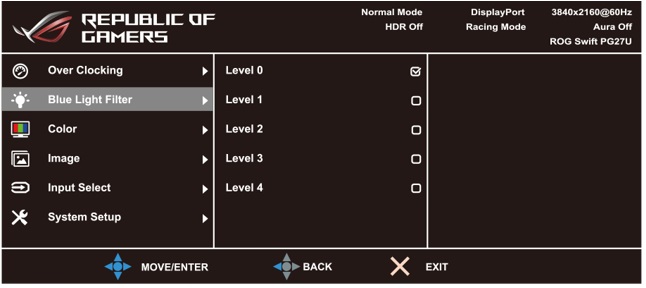
The screen offers 2x USB 3.0 ports which is
very handy although they are located on the back of the screen with the video
connections so aren't really easy access. There is also a headphone jack if you
are sending sound to the screen via HDMI, although there's no integrated
speakers offered here. There is a built in ambient light sensor which is located
on the top edge of the screen and is accessible via the 'Auto SDR brightness'
setting in the OSD. We found that this made the image darker than we might like
by default compared with our calibrated state. You can change the brightness
control though to set your normal brightness level in your normal working
conditions, and then let the auto sensor adjust this up and down in line with
any changes to your ambient light conditions throughout the day. There aren't
any other extras like card readers provided here which are sometimes useful on
office environments. The stand offers a wide range of adjustments which is great
news, allowing you to obtain comfortable viewing positions easily.

Responsiveness and Gaming
Introduction
and Testing Methodology
|
Panel Manufacturer and
Technology |
AU Optronics AHVA
(IPS-type) |
|
Panel Part |
M270QAN02.2 |
|
Quoted G2G Response Time |
4ms G2G (with OD) |
|
Quoted ISO Response Time |
n/a |
|
Overdrive Used |
Yes |
|
Overdrive Control
Available Via OSD Setting |
OD |
|
Overdrive OSD Settings |
Off, Normal, Extreme |
|
Maximum
Refresh Rate |
60Hz (HDMI)
120Hz (native)
144Hz (with overclock) |
|
Variable
Refresh Rate technology |
NVIDIA G-Sync |
|
Variable
Refresh Rate Range
|
30 - 120/144Hz |
|
Blur
Reduction Backlight |
n/a |
The PG27UQ is rated by Asus as having a
4ms G2G response time. The screen uses
overdrive / response time compensation (RTC) technology to boost pixel
transitions across grey to grey changes as with nearly all modern displays.
There is a user control in the OSD menu for the overdrive under the 'OD' setting with 3 options available -
Off, Normal and Extreme. The part
being used is
AU Optronics M270QAN02.2 AHVA (IPS-type) technology panel. Have a read
about response time in our
specs section if you need additional information about this measurement.
We use an
ETC M526
oscilloscope for these measurements along with a custom photosensor device.
Have a read of
our response time measurement article for a full explanation of the testing
methodology and reported data.
Graphics Card and System Considerations
|
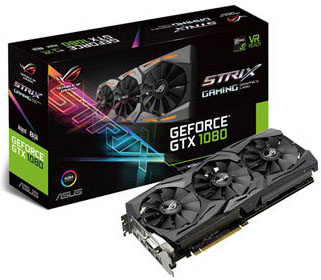 |
|
Check Pricing and Buy - Direct Links
|
|
NVIDIA
Geforce Graphics Cards:
Amazon USA |
Amazon
UK |
Overclockers UK |
Amazon GER |
Amazon CAN
|
|
TFTCentral is a participant
in the Amazon Services LLC Associates Programme, an affiliate
advertising programme designed to provide a means for sites to earn
advertising fees by advertising and linking to Amazon.com, Amazon.co.uk,
Amazon.de, Amazon.ca and other Amazon stores worldwide. We also
participate in a similar scheme for Overclockers.co.uk. |
|
Our thanks to Asus for also loaning us a ROG
NVIDIA Geforce GTX 1080 graphics card to allow full testing of this screen. You
will need to keep in mind that the PG27UQ is a very top-end display and to power
it, you are going to need a powerful system for sure. Achieving 3840 x 2160
resolution at up to 144Hz refresh rate and for HDR gaming at high settings is
going to be a challenge for even the best systems so to really make use of this
display you are going to also need to invest in other expensive, powerful
hardware. Note that it is important that your graphics card has a DisplayPort
1.4 interface as you are going to need that to achieve 4K at these high refresh
rates. Asus provide a DP cable in the box so you don't need to worry about that
thankfully.
Is 4K too high a resolution for a 27" screen
like this? That's another common question we see asked, and a lot of people
would prefer it if the screen was a little bigger in size.
AU
Optronics who produce the panel used here are also now planning a 32"
equivalent. Panel production was originally expected around Q3 2018 but our most
recent information suggests this has slipped back to Q1 2019, presumably because
of the delays and challenges with the 27" versions. It will not be until
probably middle of 2019 at best before any monitors featuring those panels we
expect right now. Given how many times the 27" panel slipped, we wouldn't be
surprised to see the same with the larger 32" version.
At 27" in size, the Ultra HD resolution can't
really be used for desktop / general use without scaling in place, as the fonts
and text are just too small. For gaming and multimedia you do get an improvement
in the image sharpness and clarity thanks to the smaller pixel pitch and higher
PPI. Depending on your viewing distance, eye sight and game settings you may or
may not notice the difference in running at 4K resolution on a 27" screen
compared with a more common 1440p display. However, there are plenty of people
out there who do notice the difference and have invested in 4K resolution
screens of various sizes, many in this kind of range, and love that extra level
of detail and clarity they get.

Response Times 60Hz (Consoles)



We carried out some initial response time
measurements in each of the overdrive settings, along with some visual tests in
order to identify what the optimal setting was. These tests were initially
carried out at 60Hz which is going to be your limit on this screen if you're
connecting a games console over HDMI at 3840 x 2160 Ultra HD resolution.
With the OD setting 'off' the average G2G
response times were fairly slow at 12.9ms G2G which is quite typical for an
IPS-type panel. Switching up to 'normal' mode brought about some noticeable
improvements to motion clarity and reductions in the measured response times,
and perceived blurring on moving images. Average G2G was now measured at 9.3ms,
and there was thankfully no overshoot problems introduced. Pushing up to the
'extreme' setting helped reduce the response times a little more, down to 8.2ms
G2G now. A small amount of overshoot was introduced, but it was minimal and not
really noticeable in practice. Response times were more than adequate to keep up
with the 60fps frame rate at 60Hz, and we would recommend opting for the
'Extreme' mode if you're gaming from a console or running at 60Hz.

High Refresh Rates and 120Hz
98Hz Refresh Rate

120Hz Refresh Rate


When connected to a PC using the DisplayPort
1.4 interface you have access to the high refresh rate of the panel. The maximum
native refresh rate supported is 120Hz, which we will remind you is a big step
up for panels of this 4K resolution. The overdrive behaviour of the screen
does vary depending on the active refresh rate. We measured the response
times with and without G-sync activated in the NVIDIA control panel
incidentally, and it had no real impact to the measurements.
We didn't bother testing the 'off' mode here,
but the 'normal' mode showed a good improvement compared with at 60Hz, with
average G2G response time improving from 9.3ms to 6.9ms when at 98Hz, and a
little lower at 6.6ms at 120Hz. The reason for testing 98Hz will become clearer
later on in the review but gives a good mid-way measurement as well between 60
and 120Hz. There was still no overshoot issues at all which was great news in
the 'normal' OD mode. These improvements in response times helps ensure the
screen can keep up with the increased frame rates. At 120Hz, a new frame is sent
to the screen every 8.33ms (1000ms / 120 frames = 8.33ms) and so the pixel
response times need to be consistently and reliably below that to ensure optimal
experience. This also avoids any additional blurring and smearing which can
commonly appear if the response times are not fast enough to keep up with the
frame rate. Motion tests in practice showed smoother and clearer moving images,
helped by the improvements to pixel response times but mainly because of the
doubling of the refresh rate.
Pushing the OD setting up to the maximum
'extreme' setting improved the response times slightly, but unfortunately a
large amount of overshoot was introduced, and you could see dark trails and
artefacts on moving content. We would recommend sticking with the 'normal'
mode if you are using the screen for refresh rates above 60Hz. This also
applies if you are going to be using NVIDIA G-sync where refresh rate range
might fluctuate within the refresh rate range supported.
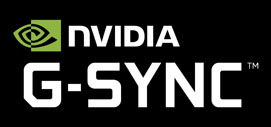
The presence of NVIDIA G-sync is very
important on this screen given the huge system demands of powering a screen at
4K resolution. This will dynamically control the refresh rate and remove tearing
and stuttering without any of the added lag that older vsync technology causes.
G-sync works by synchronizing the display’s refresh interval
with the incoming frame rate, banishing lag and ensuring gameplay stays
buttery-smooth even when there are large changes in system rendering times. Its
presence helps eliminate jarring visual artifacts, and even allows a single,
high-performance graphics card to leverage many of the PG27UQ’s benefits.
One thing sadly missing
from this screen is support for an
ULMB (Ultra Low Motion Blur) strobing backlight. This was not possible to
include with the FALD backlight sadly. Although G-sync is far more useful and
valuable anyway given the high demands of the 4K resolution and high
refresh rates. You can't use ULMB and G-sync at the same time, so even if it was
available, it would not be as useful as the G-sync variable refresh rate
support.

Overclocking and 144Hz
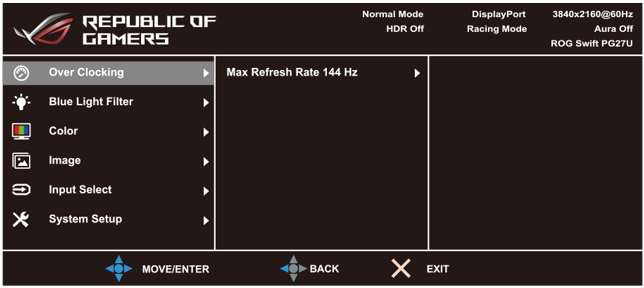
The PG27UQ can also support an overclocked
refresh rate of 144Hz if you really want to push the capabilities of the
DisplayPort 1.4 connection and be at the bleeding edge of refresh rate and
resolution support. There are a few things you need to do and be aware of to use
144Hz, some of which sound a bit complicated but actually aren't (if we can
hopefully explain them clearly for you).
First the simple part. You need to enable the
overclocked refresh rate in the OSD menu as shown above. The screen reboots and
it should then be an available option in the NVIDIA graphics card control panel.
We would recommend using the provided DisplayPort cable, or a high quality cable
to ensure support and stability for 144Hz. We had no issues enabling or using
144Hz from our test system using the provided cable.
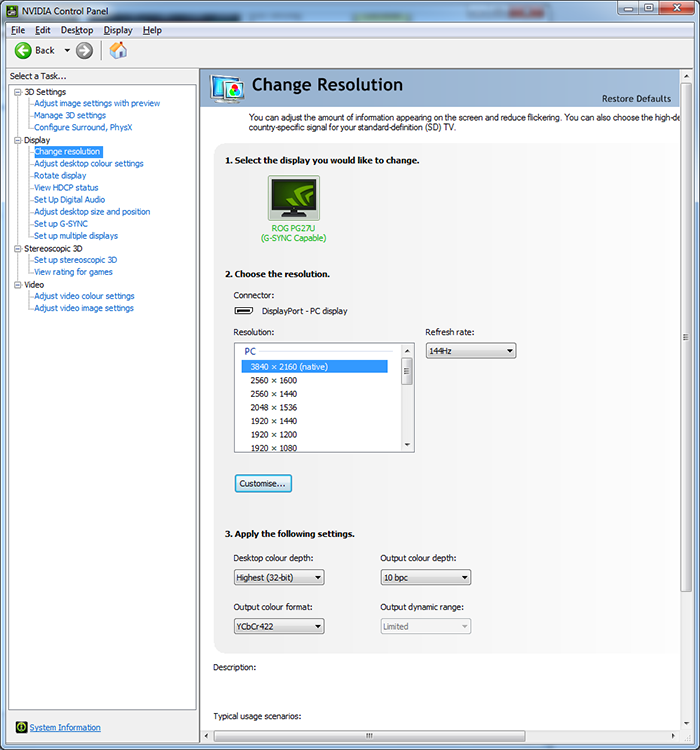
Once activated on the monitor you should see
144Hz listed as an available refresh rate in the NVIDIA control panel, including
when running at the native 3840 x 2160 resolution. To have access to 144Hz
refresh rate you need to change the 'output colour format' to YCbCr422 as shown
above. We will explain what this is about in the next section.

After enabling the 144Hz overclock via the
OSD menu and making the necessary setting changes in the NVIDIA control panel we
measured the response times again at the optimal 'normal' setting. We could tell
from visual tests that the 'extreme' setting continued to show high levels of
dark overshoot as it had done at 120Hz in our tests above. At 144Hz there was
again a small improvement to response times, now lowering to 5.9ms G2G from
6.6ms we'd seen at 120Hz. Again this helped ensure pixel transitions were fast
enough to keep up with the increased frame rate, as they need to be <6.94ms to
keep up at 144Hz. This overclocking feature seemed to work well.
You need to be aware of the colour
compression that is needed to make 144Hz possible at this resolution which
brings us on to....

Chroma Sub-sampling
To achieve a "4K" (3840 x 2160, strictly
Ultra HD) resolution and high refresh rates the bandwidth capabilities of the
latest DisplayPort 1.4 interface are already being pushed to their limit. The
interface is just not capable of supporting the really high end of the refresh
rate without some sacrifices, and so to achieve the higher end refresh rates you
will have to lower the colour support in one of a couple of ways. This might
sound like a big sacrifice, but don't be too alarmed. We will try and explain.
The easy part here is refresh rates up to
98Hz maximum. That is within the bandwidth capabilities of DP 1.4 without any
colour compression being needed, and therefore you can run the screen just like
you would any other display. It will support the full 3840 x 2160 resolution, up
to 98Hz refresh rate and with 10-bit colour depth support as well if you have a
game that can make use of it.
As we explained
earlier, 10-bit colour depth support is only applicable for gaming on this
display given the limitations of Geforce gaming graphics cards, and not for
professional applications like Photoshop. This is useful for HDR gaming
where 10-bit colour depth is more commonly used and a lot of other games may not
even support 10-bit anyway. No colour compression is needed for refresh rates up
to 98Hz anyway so 10-bit is there if you need it.
If you want to push the screen up to high
refresh rates >98Hz then some kind of colour compression is required so that it can
fit within the bandwidth capabilities of DP 1.4. There are two ways this can be
achieved
1) Drop from 10-bit colour depth to
8-bit - this might not actually make any real difference for many games,
especially if they are non-HDR games or just simply don't support 10-bit
colour depth. In a game where 10-bit is supported, or in HDR gaming you may
see some improvements in colour gradients when using 10-bit over 8-bit but
then again in some cases you may not see much real difference. For 120Hz
refresh rates you can drop the colour depth to 8-bit and then not worry about
the chroma sub-sampling discussed below.
2) Use Chroma Sub-sampling - this is a method for compressing the colour
information in a signal to save on bandwidth, without significantly impacting
the picture quality in many cases. This avoids the need to reduce the
luminance information (luma) in the signal which would have a more noticeable
impact on picture quality, and this method can help reduce the file size by a significant
amount.
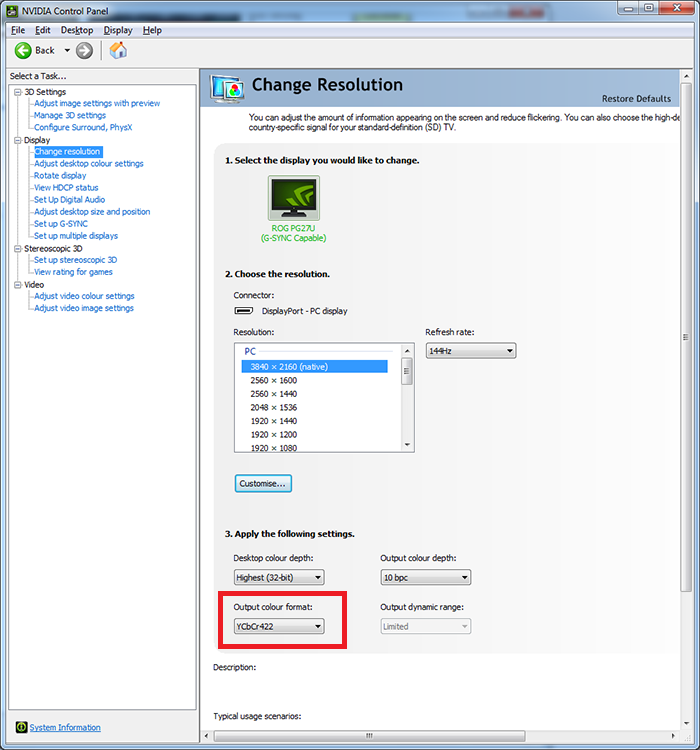
Chroma sub-sampling is represented by the
YCbCr setting in the 'output colour format' section in the graphics card
control panel we
showed earlier (copied above again for ease of reference). It is listed in a
format like 4:4:4, 4:2:2 or in some cases even 4:2:0. We will focus on 4:4:4
and 4:2:2 here as that's what is relevant to this display.
4:4:4 format is just the normal standard, uncompressed colour output where
sub-sampling is NOT needed and means that for a sample of 4 (the first digit),
there are 4 horizontal samples (second digital) and 4 vertical samples (third
digit). That's the norm and usually in the graphics card settings you would
see this listed as YCbCr444, or if it's just selected on 'RGB' then that
implies no chroma sub-sampling is needed either.
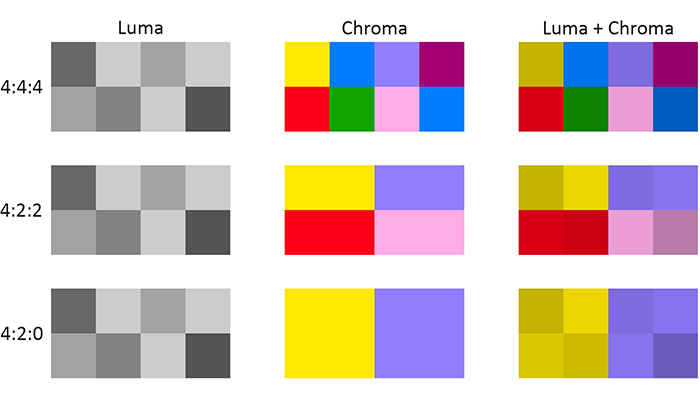
Image courtesy of
Rtings.com
4:2:2 is the colour compression option we
are interested in here for the PG27UQ. The two chroma components are sampled
at half the sample rate of luma. The horizontal chroma resolution is halved.
This reduces the bandwidth of an uncompressed video signal by one-third. On
this display if you want to run above 98Hz and maintain the 10-bit colour
depth output, then you will need to use this 4:2:2 chroma sub-sampling setting
in the NVIDIA control panel to allow support.
At 120Hz you can keep a full 4:4:4 chroma (no sub-sampling) and instead drop
to 8-bit colour depth and that will also work fine. A lot of games and SDR
content aren't even going to support 10-bit anyway. If you want to use the overclocked 144Hz refresh
rate you will have to drop to 4:2:2 chroma sub-sampling but it can then
support 8-bit and 10-bit colour depth. Here's a summary to try and make it
clear:
|
Refresh Rate |
Colour output |
Notes |
|
Up to
98Hz |
10-bit
colour depth and 4:4:4 chroma supported |
98Hz likely to be more
than enough for many users and systems anyway (see comments below) |
|
120Hz |
Choice
to drop either to 8-bit colour depth, or to 4:2:2 chroma sub-sampling |
If your game doesn't
support 10-bit anyway or you see no real difference in practice,
probably best to drop to 8-bit and keep the full 4:4:4 chroma sampling |
|
144Hz |
Must drop to 4:2:2
chroma sub-sampling but will support 10-bit colour depth |
No
choice here but to use 4:2:2 chroma sub-sampling. See below for comments
on the impact of that |
Does Chroma sub-sampling make a
difference?
You will see that when you switch to YCbCr422
mode (4:2:2 chroma sub-sampling) that the 'output dynamic range' setting in the
NVIDIA control panel also switches to 'limited'. We know from some previous
screens that often when the graphics card gets accidentally set in limited
range, it has a huge impact on the black depth and contrast ratio of the
display. That is because a limited RGB range (16 - 235 instead of the normal 0 -
255) clips some dark shades and some bright shades. We were initially concerned
about this on the PG27UQ but we need not have worried.
When running at 4:2:2 chroma mode there was
no noticeable impact to the setup of the screen. Running a test with our i1 Pro
2 showed the same gamma curve, white point and low dE that we'd seen out of the
box by default. We measured a static contrast ratio of >1000:1 as well, and
carrying out visual tests of the darkest black/grey and brightest grey/white shade samples
which
showed no noticeable difference between 4:4:4 mode and 4:2:2 mode. There was no
limiting of the contrast ratio here which was great news and it appears not to
be operating in any limited dynamic range. This applied to SDR content as well
as HDR.
Where there is an observable difference is
when viewing text. For normal day to day PC use like office documents etc, fonts
sometimes look more blurred and a little broken in places in 4:2:2 mode, particularly
with text on
solid coloured backgrounds. This is more noticeable the smaller the fonts get. The
compressed colour data makes reading text a problem sometimes if running at
4:2:2 mode although to be honest it's quite slight, and only in certain
conditions that you'd really see it. A lot of the time you'd have to go
specifically looking for it. This text blurring and clarity issue, where
visible, is a commonly observed and known side-effect of the lower chroma
sub-sampling on displays.
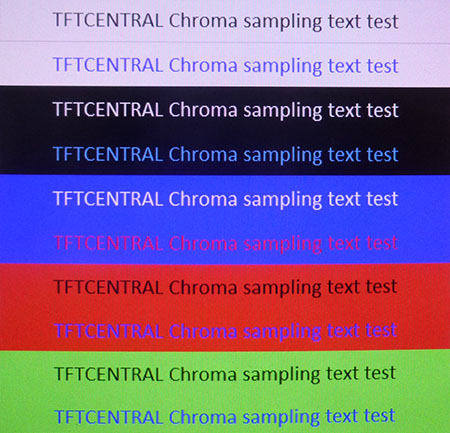
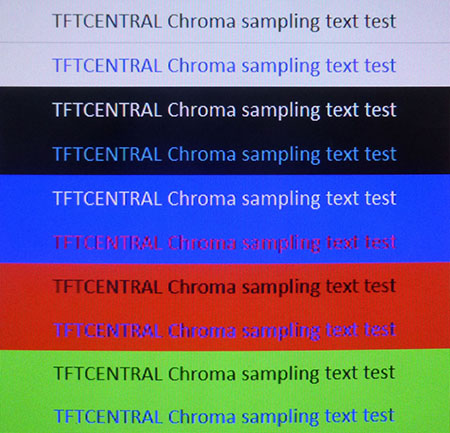
Chroma sub-sampling 4:4:4 (left) vs. 4:2:2
(right) with size 16 font at 3840 x 2160 resolution
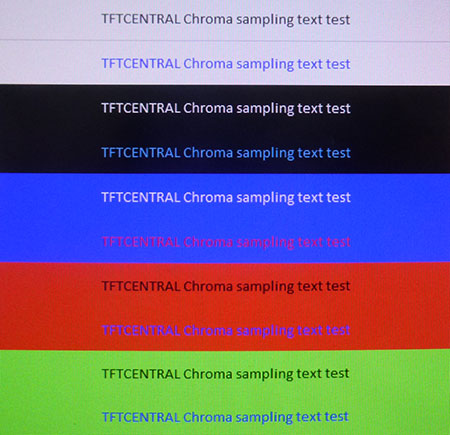
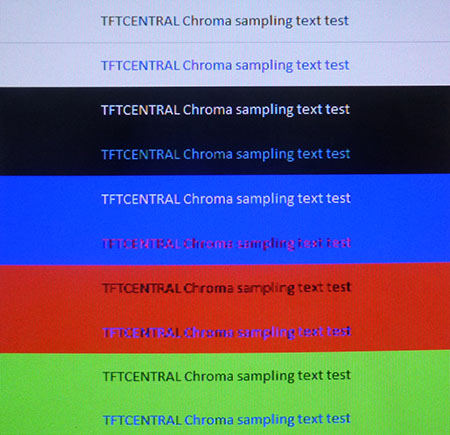
Chroma sub-sampling 4:4:4 (left) vs. 4:2:2
(right) with size 11 font at 3840 x 2160 resolution
Above are some photos taken in 4:4:4 mode and
4:2:2 mode to give you an idea of the impact the latter has on text clarity. You
can see it mainly impacts text on a coloured background, and where text is
smaller in size. In some samples it's very hard to see any difference to be
honest.
For other uses like movies and games the
difference is less noticeable. Movies, Blu-rays, external games consoles and
external Blu-ray players are all going to operate at lower refresh rates,
so there is no need to reduce the chroma to 4:2:2 anyway. You might as well run
at 4:4:4 although in many cases it actually has no noticeable benefit over lower
sampling. That's irrelevant here anyway. For gaming, if it's a game with lots of
text you may see some similar problems with text clarity as you would in desktop
use, and as shown above. Otherwise it is hard to notice a difference in many
cases and the advice it to not really worry about it. With the 4K resolution,
high refresh rate, 10-bit colour depth and HDR experience you are probably not
going to worry about any minor drops in colour fidelity we don't think.
Does this even matter? Can you reach >98Hz?
One key thing to keep in mind amongst all
this talk of colour compression is the frame rate you're realistically going to
be able to achieve with your system and graphics card when trying to power the
screen at 4K resolution. Modern HDR capable games are really going to push your
system to its limits at this resolution and with high games settings, and so
actually achieving high refresh rates above 98Hz might not be easy to achieve,
or may even be impossible to many people. So depending on your other hardware
this whole section may be somewhat irrelevant, and to many people they can just
run the screen at 98Hz maximum refresh rate and have a full 10-bit colour depth
and 4:4:4 chroma sampling (uncompressed).

Detailed Response Times
144Hz Refresh Rate, OD = Normal
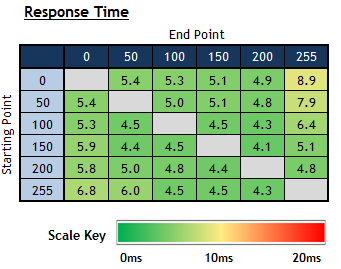
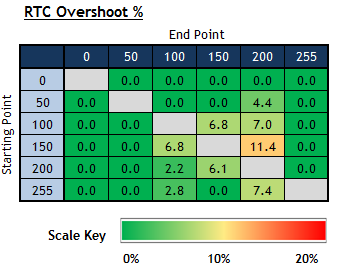
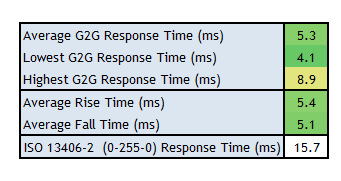
Having settled on the 'normal' OD response time
mode in our earlier measurements and visual tests we carried out a more thorough
set of measurements across a wider range of pixel transitions while at the
maximum 144Hz refresh rate. The average G2G
figure was measured at 5.3ms now which was excellent for an IPS-type panel. This
was with very low levels of overshoot that were basically unnoticeable in
practice. This screen is more than capable of handling fast paced gaming thanks
to its low response times, high refresh rate support and NVIDIA G-sync
technology.

Gaming Comparisons
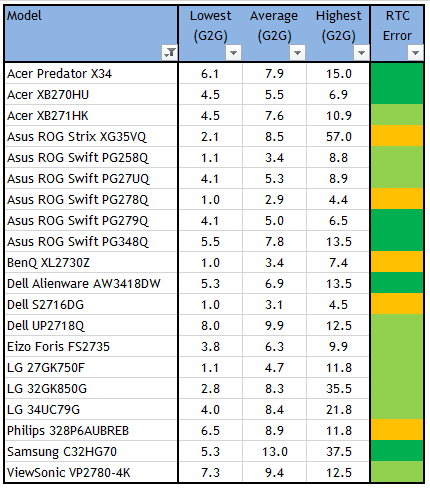
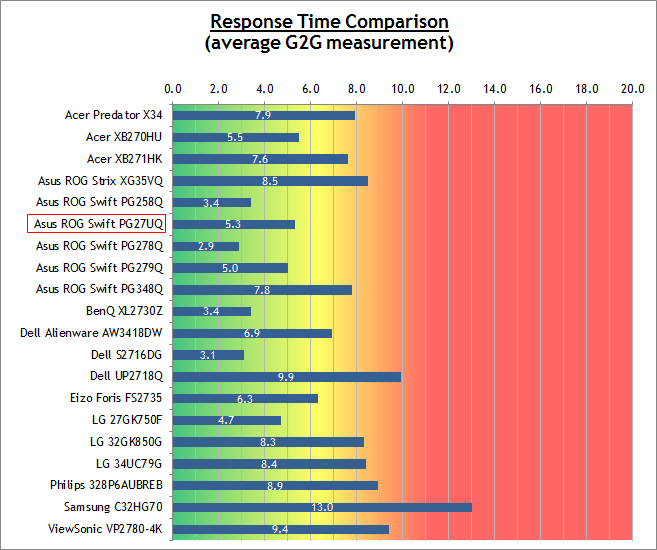
We have provided a comparison of the PG27UQ against many other screens that we have tested.
The overall responsiveness of the PG27UQ (5.3ms) was very good, and on par with
the other top end high refresh rate IPS panels we've tested, like the Asus ROG
Swift PG279Q (5.0ms) and Acer Predator XB270HU (5.5ms) for instance. This was
all with very low levels of overshoot as well which was great news. These 144Hz
compatible IPS screens offer slightly faster response times than 100 - 120Hz
capable IPS screens like the Dell Alienware AW3418DW (6.9ms) and Asus ROG Swift
PG348Q (7.8ms) for instance. The TN Film panels here like the Asus ROG Swift
PG278Q (2.9ms) and certainly the PG258Q (3.4ms) could reach a little faster,
although sometimes this is at the expense of some additional moderate levels of
overshoot.

Additional
Gaming Features
-
Aspect Ratio Control -
the screen has 3 options for
hardware level
aspect ratio control
options, with settings for full, aspect and 1:1 pixel mapping offered.
The aspect mode is really useful as it will maintain the source device aspect
ratio while filling as much of the screen as possible. If you want to directly
map pixels you can use the 1:1 mode as well.

GameVisual offers
six display presets, each optimized for a specific usage scenario. These
include:
-
FPS Mode:
Enhanced visibility in First Person Shooter gameplay.
-
RTS/RPG Mode:
Enhanced color and sharpness in Real-Time Strategy / Role-Playing Games.
-
sRGB Mode:
Optimized for photos and graphics on your PC.
-
Racing Mode:
Created for real-time racing and fast gaming
experience.
-
Cinema Mode:
Contrast and color saturation for livelier and vivid visuals during
movies.
-
Scenery Mode:
Increased brightness, contrast gradation plus color saturation tweaks for
viewing photographic scenes.
Note: GameVisual
options are only available when using SDR mode.

-
GamePlus - offers additional overlays to aid and
enhance the games you play. As they are built into the display OSD, they can
be applied to any game. A countdown timer and aiming crosshair, with options
of styles and placements, are available. There’s also an overlay with
alignment arrows to aid precise calibration of multi-monitor setups.


-
ROG Light Signal - ROG Light Signal resides at the top
of the stand, projecting the ROG logo onto the ceiling above. Both Light
Signal and Light Signature are controlled from the OSD, with Light Signature
offering three levels of illumination intensity. You can also control the
angle of the projection using a small slider control on the back of the stand.

-
ASUS Aura Sync
- this technology creates immersive ambient lighting and supports
synchronization with Aura-enabled components and peripherals.
To achieve perfect synchronisation, simply
connect ROG Swift PG27UQ to other peripherals by installing the Aura Sync
software on your laptop or desktop. Enjoy the coolest and most stylish
backdrop for any gaming setup, and have all lights pulsing to the beat of your
favourite music or game sound effects. With an eco-system
that spans over 100 devices, there’s scope to create a cohesive visual theme
from the PC all the way to the desktop and beyond.

-
Rear ROG logo lighting - a large ROG logo on the rear
of the monitor can be controlled using either the monitor OSD (with several
styles of RGB color cycling) or by AURA Sync software via a USB connection to
the PC. This allows colors and effects to be synchronized with a range of Aura
Sync-compatible hardware.

Lag
We have written an in depth article about
input lag and the various measurement techniques which are used to evaluate
this aspect of a display. It's important to first of all understand the
different methods available and also what this lag means to you as an end-user.
Input Lag vs. Display Lag vs. Signal
Processing
To avoid confusion with different terminology
we will refer to this section of our reviews as just "lag" from now on, as there
are a few different aspects to consider, and different interpretations of the
term "input lag". We will consider the following points here as much as
possible. The overall "display lag" is the first, that being the delay between
the image being shown on the TFT display and that being shown on a CRT. This is
what many people will know as input lag and originally was the measure made to
explain why the image is a little behind when using a CRT. The older stopwatch
based methods were the common way to measure this in the past, but through
advanced studies have been shown to be quite inaccurate. As a result, more
advanced tools like SMTT provide a method to measure that delay between a TFT
and CRT while removing the inaccuracies of older stopwatch methods.
In reality that lag / delay is caused by a
combination of two things - the signal processing delay caused by the TFT
electronics / scaler, and the response time of the pixels themselves. Most
"input lag" measurements over the years have always been based on the overall
display lag (signal processing + response time) and indeed the SMTT tool is
based on this visual difference between a CRT and TFT and so measures the
overall display lag. In practice the signal processing is the element which
gives the feel of lag to the user, and the response time of course can
impact blurring, and overall image quality in moving scenes. As people become
more aware of lag as a possible issue, we are of course keen to try and
understand the split between the two as much as possible to give a complete
picture.
The signal processing element within that is
quite hard to identify without extremely high end equipment and very complicated
methods. In fact the studies by Thomas Thiemann which really kicked this whole
thing off were based on equipment worth >100,1000 Euro, requiring extremely high
bandwidths and very complicated methods to trigger the correct behaviour and
accurately measure the signal processing on its own. Other techniques which are
being used since are not conducted by Thomas (he is a freelance writer) or based
on this equipment or technique, and may also be subject to other errors or
inaccuracies based on our conversations with him since. It's very hard as a
result to produce a technique which will measure just the signal processing on
its own unfortunately. Many measurement techniques are also not explained and so
it is important to try and get a picture from various sources if possible to
make an informed judgement about a display overall.
For our tests we will continue to use the
SMTT tool to measure the overall "display lag". From there we can use our
oscilloscope system to measure the response time across a wide range of grey to
grey (G2G) transitions as recorded in our
response time
tests. Since SMTT will not include the full response time within its
measurements, after speaking with Thomas further about the situation we will
subtract half of the average G2G response time from the total display lag. This
should allow us to give a good estimation of how much of the overall lag is
attributable to the signal processing element on its own.
Lag Classification
To help in this section we will also introduce a broader classification system
for these results to help categorise each screen as one of the following levels:
-
Class 1)
Less than 6.94ns / 1 frame lag at 144Hz - should be fine for gamers, even at high
levels
-
Class 2)
A lag of 6.94 -
13.88ms
/ One to two frames at 144Hz - moderate lag but should be fine for many gamers.
Caution advised for serious gaming
-
Class 3)
A lag of more than
13.88ms / more than 2 frames at 144Hz - Some noticeable lag in daily usage, not
suitable for high end gaming
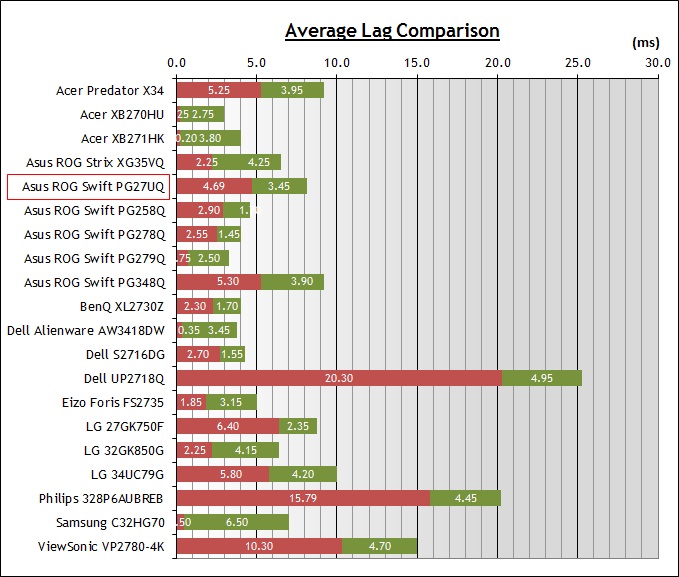
For the full reviews of the
models compared here and the dates they were written (and when screens were
approximately released to the market), please see our
full
reviews index.
|
(Measurements in ms) |
|
|
Total Display Lag (SMTT
2) |
8.14 |
|
Pixel Response Time
Element |
3.45 |
|
Estimated Signal
Processing Lag |
4.69 |
|
Lag Classification |
1 |
|

Class 1 |
We have provided a comparison above against
other models we have tested to give an indication between screens. The screens
tested are split into two measurements which are based on our overall display
lag tests (using SMTT) and half the average G2G response time, as measured by
the oscilloscope. The response time is split from the overall display lag and
shown on the graph as the green bar. From there, the signal processing (red bar)
can be provided as a good estimation.
We measured the total display lag of 8.14ms.
With approximately 3.45ms of that accounted for by pixel response times (based
on 98Hz refresh rate as a middle ground) we had
an estimated signal processing of just 4.69ms, which was next to nothing and in
keeping with other G-sync screens we've tested in the past. This shouldn't
represent any problem for fast paced or competitive gaming.

Movies and Video
The following summarises the screens
performance for videos and movie viewing:
|
Category |
Display
Specs / Measurements |
Comments |
|
Size |
27" widescreen |
Fairly standard for
desktop display today, much smaller than a TV |
|
Aspect Ratio |
16:9 |
Well suited to most
common 16:9 aspect content and input devices |
|
Resolution |
3840 x 2160 |
Can support native 1080p
content and Ultra HD content natively |
|
HDCP |
Yes v2.2 |
Suitable for encrypted
content across both ports |
|
Connectivity |
DisplayPort 1.4
HDMI 2.0 |
Useful additional HDMI
input for external Blu-ray players or games consoles. Capable of
supporting the high resolution as well |
|
Cables |
DisplayPort and HDMI |
Both provided in the box
which is good news |
|
Ergonomics |
Tilt, height, swivel,
rotate |
Good range of
adjustments which are smooth and easy to use. You should be able to position the screen for multiple viewing
positions. |
|
Coating |
Light Anti-glare |
Provides clear,
non-grainy image and avoids unwanted reflections of full glossy solutions |
|
Brightness range |
24 - 532 cd/m2 (SDR)
up to 1237 cd/m2 peak brightness in HDR mode |
Very good adjustment range
offered. Flicker free backlight operation with no PWM. In HDR mode the
FALD is capable of producing very high peak brightness >1000 cd/m2 and
strong HDR contrast ratios |
|
Contrast |
1071:1 SDR
up to 26,650:1 SDR with FALD
up to 61,850:1 in HDR mode |
Strong contrast ratio for
an IPS panel, helping provide good clarity in shadow detail
and darker content. Improved even further if you enable the FALD, even in
SDR content. The active contrast ratio will depend on how bright you make
the screen overall. HDR contrast is very strong thanks to local dimming and FALD
backlight along with high peak brightness capability. |
|
Preset modes |
Cinema |
Seems to be set up the
same as the default Racing Mode, but might be useful to customise to a
different setup for movies |
|
Response times |
5.3ms G2G at 144Hz, low
overshoot
8.6ms G2G at 60Hz |
Very good overall and
more than fine for movie viewing certainly. Stick with the 'Normal' response
time setting if running above 60Hz. For external devices you might want to
push up to the 'Extreme' OD mode |
|
Viewing angles |
Very good |
Thanks to the IPS panel
technology, suitable for viewing from a wide range of positions. Low glow
panel means dark content does not show the usual pale/white glow that you
get from many IPS panels which is great news |
|
Backlight bleed |
Very good |
No backlight bleed on our
sample (may vary) which is good, as that can be particularly problematic
on movies with black borders. Local dimming helps reduce blacks on darker
content nicely |
|
Audio |
Headphone jack |
No integrated speakers,
but a headphone jack available |
|
Aspect Ratio Controls |
1:1, Aspect, Full |
Good options to account
for non-native format inputs if needed |
|
PiP / PbP |
Not available |
n/a |
|
HDR support |
Yes, certified with:
VESA DisplayHDR 1000
Ultra HD Premium |
See our
HDR section for more
information |

High Dynamic Range (HDR)
HDR stands for
High Dynamic Range and is a
technology just starting to make its way in to the desktop monitor market. It's
been around in the TV market for a couple of years and is used
primarily to provide a better dynamic range and contrast to the image for
multimedia, movies and games - that
being the difference between light and dark parts of an image. This improvement
to the dynamic range is usually
paired with other specific features under the banner term of "HDR" including a wider colour gamut for richer,
more vivid colours and specs like a 10-bit colour depth support and a high Ultra HD
resolution. Overall, an HDR Capable screen is designed to offer a more life-like
images, with better contrast ratios between light and dark areas and more vivid,
bright colours. You only need to go in to a high street store to observe the
difference that HDR makes on TV sets, so we would encourage you to do that if
you want to see first hand the improvements it makes to the image quality.
HDR Standards Conformity


|
Ultra HD
Premium Spec Guidelines
|
Yes/no
|
Display Spec
|
|
At least Ultra HD
Resolution 3840 x 2160 |
 |
3840 x 2160 supported |
|
10-bit colour depth
processing |
 |
8-bit + FRC panel |
|
DCI-P3 colour space
coverage |
 |
110.3% DCI-P3 measured |
|
Suitable HDR connectivity |
 |
DisplayPort 1.4 and HDMI 2.0 |
|
at least 1000 cd/m2 peak luminance |
 |
1236 peak cd/m2 measured |
|
at least 20,000:1 active contrast ratio |
 |
61,800:1 maximum measured |
|
|
|
Backlight dimming system
(not defined in Ultra HD Premium requirements) |
384-zone Full Array Local
Dimming (FALD) |
The
PG27UQ is heavily promoted for its HDR capabilities, and unlike many screens in
the market this one does actually live up to the billing. It even carries
official certification under the new VESA DisplayHDR 1000 standards, and the
established TV Ultra HD Premium certification as well making it a "true" HDR
screen.

Local dimming is achieved through a 384-zone (24 x 16) Full Array Local Dimming
(FALD) backlight for the best HDR dimming performance you can currently get from
an LCD panel. OLED screens in the TV market can offer superior local dimming,
but for LCD screens FALD is the preferred method, and the more zones, the better.
This means small areas of the screen can be brightened while others are dimmed,
and it gives a far better level of control compared with typical edge-lit local
dimming options which have far few zones. Read
our HDR article for more information about these methods to achieve local
dimming necessary for HDR. Even with 384 zones you will see some blooming around
small bright objects on a dark background, and that's unavoidable. Mouse cursors
on dark backgrounds are an unrealistic real-world test and you can spot the
blooming around them quite easily. But in real HDR content and multimedia, there
were low levels of blooming apparent and it operated very well.
This FALD allows the screen to offer the necessary 1000 cd/m2 peak brightness spec
required for the certifications and to provide a great dynamic range contrast in
practice. The Quantum Dot coating boosts the colour gamut so that there is a
high DCI-P3 coverage, and the 8-bit+FRC panel supports 10-bit colour depth too.
You
need to enable the 'variable backlight' option in the OSD menu to operate the
FALD for local dimming benefits. We will test the settings and performance of
the FALD in a moment.
HDR
Contrast and Peak Brightness
We measured the luminance and contrast performance of the
screen in HDR mode in a variety of scenarios. A white box is displayed on the
screen which covers 1% of the overall screen size initially. This is designed
to show at several target luminance levels, starting at 100 and then changing to
400 and 1000 cd/m2 (and beyond if needed). We measure the actual
luminance of that white box to see how close to the target luminance the screen
actually performs at each step. When the screen reaches the maximum peak
luminance possible, we also measure the black depth of the screen at a point
furthest away from the white area. This can then allow us to calculate the HDR
active contrast ratio, the difference between the bright white area on screen, and the
dark black areas elsewhere.
This 1% white screen coverage is designed to give a rough representation of how
a small highlight area in HDR content might appear and work in normal
multimedia. The box then increases to a larger size, covering 4, 9, 25, 49 and
finally 100% of the screen area. This represents different sized areas of bright
content in HDR multimedia. Again those progressively larger boxes are shown at
the different luminance targets, and we measure the actual screen luminance
achieved for each.
Updated Measurements 6/8/18
When
you enable are inputting an HDR signal either from Windows or an external
device, the monitor automatically detects this and switches to HDR mode. Some
options like 'brightness' are no longer available. You can however adjust the
'reference white (nits)' control yourself, and this has an impact on the
brightness levels achieved by the screen. It's default is 80.
PC
Input, DisplayPort, Windows 10
Reference White (nits) = change to
52
|
White window size |
100 cd/m2 target |
400 cd/m2 target |
1000 cd/m2 target |
2000 cd/m2 target |
4000 cd/m2 target |
|
Peak luminance
(cd/m2) |
Min black depth
(cd/m2) |
HDR contrast (x:1) |
|
1% |
103 |
435 |
998 |
1014 |
1014 |
|
1014 |
0.02 |
50,700 |
|
4% |
101 |
428 |
1026 |
1236 |
1236 |
|
1237 |
0.02 |
61,850 |
|
9% |
99 |
422 |
1005 |
1189 |
1189 |
|
1189 |
0.03 |
39,633 |
|
25% |
98 |
417 |
859 |
853 |
853 |
|
853 |
0.05 |
17,060 |
|
49% |
98 |
417 |
711 |
711 |
711 |
|
711 |
0.12 |
5,925 |
|
100% |
98 |
417 |
654 |
654 |
654 |
|
654 |
n/a |
n/a |
We
carried out these measurements first of all with the default 80 'white
reference' setting but found that the content targets were being exceeded by
quite a lot and the screen was basically too bright. Content mastered at 400
cd/m2 was being shown at around 650 cd/m2. You
will probably want to lower the white reference setting to 52 in the OSD menu,
and that then produced the results shown above which were nice and accurate.
At all sample sizes from 1% to 100% white
coverage, the targets for 100 cd/m2 and 400 cd/m2 where
reached pretty accurately which was good news. Content mastered at 1000 cd/m2
was also met nicely where it was covering small areas of the screen which is
great for small highlights and small bright areas on a screen. You don't really
want larger areas of the screen to be too bright as it can be harsh on the eyes.
When the white area reached 25% screen coverage the peak luminance was a little
lower at around 859 cd/m2. This peak luminance lowered a bit more as
the white area increased in size which is what you'd probably want, to avoid it
being overly bright and harmful to the eyes. Actually we did observe that for
about 3 seconds the screen would jump up to the full peak luminance of ~1000
cd/m2 but would then drop down and stabilise at the figures shown
above. So it will temporarily show the full 1000 cd/m2 content
brightness but won't stay at that level for too long.
The
absolute peak luminance of the screen measured was around 1236 cd/m2
which represents the upper limit of the backlight capabilities and is actually a
fair amount beyond the manufacturer spec of 1000 cd/m2. This was
achieved when the screen tried to show content mastered at 2000 and 4000 cd/m2
levels.
With
a peak luminance of around 1237 cd/m2 possible, we measured a black
point on the same screen of 0.02 cd/m2. This gives rise to a maximum HDR contrast ratio of
61,850:1 which was excellent and a long way beyond the normal static contrast ratio of around
1071:1. The FALD is capable of brightening the light areas of the screen very
well, particularly if the content input is designed to be 1000 cd/m2
or more, and at the same time is able to dim the dark areas to a very low black
point. The results above were based on a PC connection over DisplayPort and so
this is of most interest here given the PG27UQ is primarily a PC gaming screen.
Your HDR games should show reliable brightness performance along with very
strong HDR contrast ratios in practice.
HDMI External Input
Reference White (nits) = default
80
|
White window size |
100 cd/m2 target |
400 cd/m2 target |
1000 cd/m2 target |
2000 cd/m2 target |
4000 cd/m2 target |
|
Peak luminance
(cd/m2) |
Min black depth
(cd/m2) |
HDR contrast (x:1) |
|
1% |
110 |
405 |
659 |
914 |
1107 |
|
1107 |
0.02 |
55,350 |
|
4% |
106 |
392 |
635 |
926 |
1237 |
|
1237 |
0.02 |
61,850 |
|
9% |
105 |
388 |
632 |
918 |
1200 |
|
1200 |
0.03 |
40,000 |
|
25% |
104 |
377 |
597 |
906 |
846 |
|
846 |
0.05 |
16,920 |
|
49% |
104 |
385 |
622 |
540 |
691 |
|
691 |
0.12 |
5,758 |
|
100% |
105 |
376 |
597 |
668 |
668 |
|
668 |
n/a |
n/a |
The
above results came from our original tests published in this review before the
update above. We have left them in for completeness, but these results were
obtained when connecting an external device capable of HDR content
over the HDMI interface. This is a simpler setup, removing all the complications
with Windows, software, graphics cards etc and will give you a representation of
the screens behaviour when connecting an external device like a Blu-ray player
or Games Console in theory.
At all sample sizes from 1% to 100% white
coverage, the targets for 100 cd/m2 and 400 cd/m2 where
reached quite accurately which was good news.
When
it comes to 1000 cd/m2 target content, the screen didn't reach the
desired luminance at any of the sample sizes. For some reason the screen behaves
a bit differently, perhaps because of the HDMI interface being used here. You can alter the 'reference white
(nits)' setting in the OSD if you want, and by increasing that from the default
80 level up to around 168, an approximate 1000 cd/m2 figure was
achieved. The backlight is certainly capable of it. That has the knock on effect
though of making the 100 cd/m2 and 400 cd/m2 content
brighter than it should be. It is probably best to leave the setting at the
default 80, as you don't want all the darker 100 - 600 cd/m2 range
content being brighter than it should be, especially if you're using the screen from
up close.
Content designed for 2000 cd/m2 actually produced a luminance closer
to the 1000 cd/m2 peak brightness spec of the screen, where the white
sample size was 1 - 25% of the screen area. So any content designed to be really
bright will push the backlight capabilities to their limits. When the white
sample size becomes larger at 49% of the screen or more, the luminance is
lowered to around 540 - 668 cd/m2 so as not to blind you with a
really large white area at a mega-high luminance. That is a good thing, as you
really only want small screen areas to reach the upper peak brightness levels
possible so as not to hurt your eyes.
Content mastered at 4000 cd/m2 actually pushed the screen to reach
it's upper limit of brightness possible from the FALD backlight. We reached 1237
cd/m2 in the best example (4% screen coverage of a white sample),
which was beyond the peak brightness spec from Asus by quite a long way in fact.
With
a peak luminance of around 1237 cd/m2 possible we measured a black
point on the same screen of 0.02 cd/m2. This gives rise to a maximum HDR contrast ratio of
61,850:1 which was excellent and a long way beyond the normal static contrast ratio of around
1071:1.
FALD Speed
The
challenge with local dimming backlights is getting them to operate fast enough
so that they can keep up with the changing screen content, particularly for PC
gaming where you are viewing the screen from close up. You need a backlight that
can respond nice and quickly to changes in brightness and darkness to produce an
optimal HDR experience. This helps avoid trails and haloing behind moving
objects and reduces the blooming affect as a result. Asus and NVIDIA have worked
very hard to get the FALD backlight operating at high refresh rates and with
G-sync, and have invested a lot of development time in getting the FALD to
respond quickly.
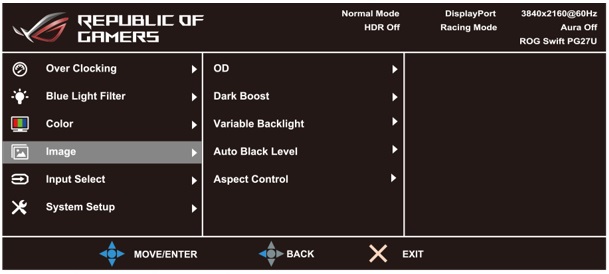
Three settings are available in the OSD menu to control the speed of the
'variable backlight', and this works in SDR and HDR content. There are settings
for gradual, medium and fast available.
We
looked at the speed of the FALD backlight when we tested the
Dell UP2718Q back in December 2017, which was the first desktop monitor of
its kind with this kind of backlight. By using the
a simple moving white circle test pattern we measured how quickly the FALD backlight brightens and then dims the
backlight. We measure the change in screen luminance as the white moving circle
passes in front of our photosensor.
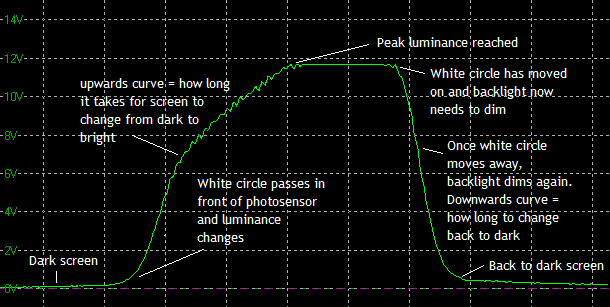
Example graph annotated to explain what is being measured. Taken from the Dell
UP2718Q
Above is a measurement of the Dell UP2718Q's FALD backlight purely to explain
what we are measuring and what the graph means. We have annotated
the graph to make it easier to understand. We can establish how long it takes the screen to reach the
peak luminance, and how long it takes the screen to return to darkness after the
white circle has moved on. There is an element of pixel response times in here,
but what we're interested in is the overall time it takes for the screen to
reach the desired bright peak, and then drop back down to the dark point again.
We tested this using an HDMI input source at 60Hz and with the OD setting at
normal.
Gradual Setting
|
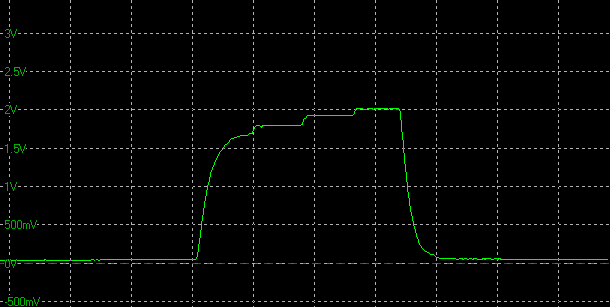 |
FALD total delay time
|
Total Rise Time |
34ms |
|
Total Fall Time |
6ms |
|
It
takes 34ms for the
FALD backlight to carry out the change from showing dark content to the peak
luminance output it will reach. It then takes the
FALD backlight only 6ms to switch back to darkness after the white
circle has moved away. The FALD is very quick at switching back to an 'off'
state and returning from bright content back to darkness. It is a little slower
reaching the peak brightness but a lot faster than we'd seen on the Dell UP2718Q
which was 624ms rise time! The fast fall time back to black helps avoid pale
halos and trails behind moving objects which is very important.
Medium Setting
|
 |
FALD total delay time
|
Total Rise Time |
17.5ms |
|
Total Fall Time |
6ms |
|
It
takes 17.5ms for the FALD backlight to carry out the change from showing dark
content to the peak luminance output it will reach. It then takes the FALD
backlight only 6ms to switch back to darkness after the white circle has moved
away. The FALD is now faster at changing from dark to bright on the rise time,
helping to optimise the appearance of HDR content.
Fast Setting
|
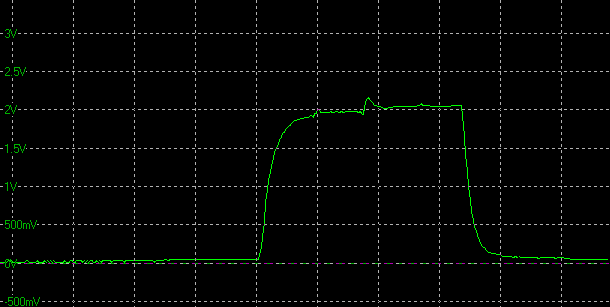 |
FALD total delay time
|
Total Rise Time |
10.5ms |
|
Total Fall Time |
6ms |
|
It
takes only 10.5ms for the FALD backlight to carry out the change from showing
dark content to the peak luminance output it will reach now. It then takes the
FALD backlight only 6ms to switch back to darkness after the white circle has
moved away. The FALD is even faster now, operating very quickly and not really
adding much lag on top of the pixel response times. We expect the 'fast' setting
to be preferred for fast paced gaming and it responds very quickly to content
changes. If you experience any flashes or the changes are too abrupt for your
content, you can drop back to one of the other settings if you wish.
Using HDR Complexities
We
will repeat what we said in some of our previous reviews here as it's an
important consideration you need to make. We should touch on the complexities of
using HDR at this stage though, especially from a PC. It's actually quite
complicated to achieve an HDR output at the moment from a PC and something you
should be aware of before jumping straight in to a modern HDR screen.
You
will need to ensure you have a compatible Operating System for a start. The
latest Windows 10 versions for instance will support HDR, but from many systems
you will see some odd behaviour from your monitor when it is connected. The
image looks dull and washed out as a result of the OS forcing HDR on for
everything. HDR content should work fine (if you can achieve it - more in a
moment!) and provide a lovely experience with the high dynamic range and rich
colours as intended. However on some Windows 10 versions, normal every day use
looks wrong with the HDR option turned on. Windows imposes a brightness limit of
100 cd/m2 on the screen so that bright content like a Word Document
or Excel file doesn't blind you with the full 1000 cd/m2 capability
of the backlight. That has a direct impact on how the eye perceives the colours,
reducing how vivid and rich they would normally look. It also attempts to map
the common sRGB content to the wider gamut colour space of the screen causing
some further issues. Sadly Windows isn't capable at the moment of turning HDR
on/off when it detects HDR content, so for now it's probably a case of needing
to toggle the option in the settings section (settings > display > HDR and
Advanced Color > off/on). Windows does seem to behave better when using HDMI
connectivity so you may have more luck connecting over that video interface,
where it seems to switch correctly between SDR and HDR content and hopefully
negate the need to switch HDR on and off in the Windows setting when you want to
use different content. This is not any fault of the display, and perhaps as HDR
settles a bit more we will have better OS support emerge. The latest Windows 10
updates have reportedly improved things somewhat.
That is a little fiddly in itself, but a current OS software limitation. The
other complexity of HDR content from a PC is graphics card support. The latest
NVIDIA and AMD cards will support HDR output and even offer the appropriate
DisplayPort 1.4 or HDMI 2.0a+ outputs you need. This will require you to
purchase a top end graphics card if you want the full HDR experience, and there
are some added complexities around streaming video content and protection which
you might want to read up on further. There are graphics cards now available to
provide that HDR option from a PC, but they are going to be expensive right now.
Finally, content support is another complex consideration from a PC. HDR movies
and video including those offered by streaming services like Netflix, Amazon
Prime and YouTube currently won't work properly from a PC due to complicated
protection issues. They are designed to offer HDR content via their relevant
apps direct from an HDR TV where the self-contained nature of the hardware makes
this easier. So a lot of the HDR content provided by these streaming services is
difficult or impossible to view from a PC at the moment. Plugging in an external
Ultra HD Blu-ray player with HDR support is thankfully simpler as you are
removing all the complexities of software and hardware there, as the HDR feature
is part of the overall device and solution.
PC
HDR gaming is a little simpler, if you can find a title which supports HDR
properly! There are not that many HDR PC games around yet, and even those that
support HDR in the console market will not always have a PC HDR equivalent.
Obviously more will come in time, but it's a little limited at the time of
writing.
Where you have everything in place and a decent game that supports HDR, the
PG27UQ will offer some excellent performance thanks to
the 384-zone FALD with fast operation, high peak brightness and high HDR
contrast ratio support. There is wide colour space coverage and 10-bit colour
depth offered as well to enhance the colours and appearance of the image
further.
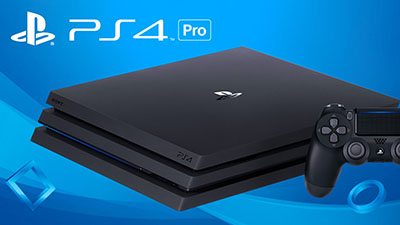
The other area to consider here is console
HDR gaming. Thankfully that part of the gaming market is a bit more mature, and
it's far simpler to achieve HDR thanks to the enclosed nature of the system - no
software, graphics card or OS limitations to worry about here. If you have a
console which can output HDR for gaming such as the PS4, PS4 Pro or X Box One S
then the monitor will support those over the HDMI 2.0 connection.
None of these complexities are the fault of the display, and we should make it
clear that the PG27UQ is certainly capable in itself of a very high level of HDR
content support, and will be HDR-ready for you in the future. You just need to
be aware of the difficulties in actually getting HDR working from the PC side of
things right now and understand that it might limit your uptake of HDR material
as a consumer at the moment. The TV market is a simpler space for HDR right now,
but although HDR is now emerging in the monitor market, the driving PC content
side of things still needs time to catch up and settle.

Conclusion
We spend a massive amount
of time producing these detailed reviews, and this one seems to be even bigger
than normal! Loads to test and plenty of exciting and interesting things to look
at. If you appreciate and enjoy our reviews, and would like to help
support
TFTCentral we really
appreciate it.
We will focus first of all on the performance
of the screen before discussing the elephant in the room, the price. The
PG27UQ is a really excellent screen all-round we felt, offering a huge range of
cutting edge features, specs and top notch performance. Gaming is its primary
purpose and it can handle that very well. There is support for 4K at up to 144Hz
which is a first in the monitor market, providing sharp, crisp, detailed images
along with the benefits that high refresh rates offer. The pixel response times
are very good and allow for great support all the way up to the overclocked
144Hz without issue, and without any noticeable overshoot being a problem.
Although you have to drop to 4:2:2 chroma for 144Hz support we found it made
little difference in multimedia and gaming and so should not be a concern to
most. Many
systems are going to struggle to reach up to those kind of frame rates so for
many it won't even matter. The presence of NVIDIA G-sync was vital given the
system demands of this res/refresh rate, and we were pleased with the resulting
low input lag as well. The only thing missing is ULMB for blur reduction, but
that's not nearly as useful as G-sync is on this display.
In other areas the out of the box setup was
excellent thanks to the factory calibration. The fact that the display uses a
low-glow IPS panel was an unexpected, but very welcome bonus, meaning you don't
suffer from the usual levels of IPS-glow that many people find annoying. HDR
performance was very good, and as good as you can get right now from an LCD
monitor thanks to the 384-zone FALD backlight. This provided great improvements
in contrast ratio both in SDR and especially in HDR content. It also showed fast
operation, improving on some of the slow FALD issues we'd seen on early
implementations on other screens. The Quantum Dot coating allowed
for wider colour gamut coverage and 10-bit colour depth support is also included
from the panel. This will all combine to offer reliable and top-end support for
HDR content and HDR games from your console and also from your PC, as long as
you can get the complicated software requirements in place.
There are plenty of extras and features
provided including a versatile and stable stand, lots of OSD extras and the
various lighting options included on the stand. Some people might moan about the
small cooling fan, but to be honest we didn't notice it as we've got a CPU fan
in our PC and it was pretty quiet really. From a performance and specs point of
view it was really an excellent screen all-round. Well done Asus!
What about the very high price?
Yes, the PG27UQ is extremely expensive
for a monitor. At the time of writing this review (dated at the top of the page)
in the UK you can buy it from
Amazon
at around £2200 GBP. In the USA you can buy it from
Amazon at around $1900 USD, and in Europe
(Germany) you can find it
for around 2450 Euro. There's
all kinds of arguments we've read online such as: "I can buy a top end OLED TV
for half that", or even "I can buy a car for that price". Obviously the price of this
screen is far beyond most monitors we've seen in recent years, but this
isn't a case of manufacturers just ripping off customers for the fun of it (and
profits). This is a bleeding-edge screen when it comes to technology, features
and specs. Many of the components are very expensive (including the FALD and
G-sync module), and the amount of R&D that
went in to producing it, getting it working, and optimising it for release is
massive. It's firmly positioned as a premium gaming screen and Asus aren't
expecting it to be suitable or available to the mass volume market. While it
might be excessively priced and out of range of many gamers, there are certainly
people out there who invest huge amount of money on the latest gaming hardware,
play very high end professionally or just have the disposable income to invest
their hard-earned money in new technology like this. The high end gaming market
is more accepting of super high end products and high pricing, and these are the
kind of gamers who will happily spend $800 - 1000 on the latest graphics cards,
not to mention other PC components to give them the most powerful and best
system for gaming they can buy. That's really where the PG27UQ is going to sit
in the market. It's never going to be accessible to a large part of the consumer
base, but that's not to say that it won't still be very popular. If you look at
the performance and features this screen offers it's an exceptional gaming
display.
Would an OLED TV be a better option?
We will just finish up by touching on a
comparison with OLED TV's, as you can buy several decent options at a much lower
price point than this monitor. Personally I think that those kind of comparisons
are meaningless, as it's a very different type of display, for very different
types of usage. If you're after a display for HDR movies, multimedia and console
gaming then yes, an OLED TV would probably be better and certainly save you some
money. They can offer superior HDR performance and the much larger format is
obviously going to be far better for those applications. But the PG27UQ isn't
really aimed at those uses. It's primarily aimed at PC gaming, from a couple of
feet away and you just aren't going to be able to use a 40 - 80" OLED TV on your
desk in that way. The PG27UQ offers much higher refresh rates for smoother
gaming, higher frame rates and improved motion clarity which are not possible
from an OLED TV. It also has the all-important G-sync support to cope with the
varying refresh rates your PC is surely going to experience when trying to power
this resolution and refresh rate. It will also offer much lower lag than a
typical OLED TV, and all these factors add up to why it's a far more suitable
screen for PC gaming and close up viewing. Not to mention the fact that it is
useable for other day to day PC use, office applications, photo editing etc
where an OLED TV is not.
Overall the PG27UQ is the best gaming screen
we've tested to date all-round. If you can afford the very high price point and
want the Rolls Royce of gaming monitors then get it!
|
Pros |
Cons |
|
4K and high refresh rates
up to 144Hz for the first time |
Very high price point |
|
HDR works very well
thanks to FALD backlight |
Small cooling fan may
bother some people with very quiet systems |
|
Great factory
calibration, and low-glow panel a pleasant surprise |
Missing ULMB strobing
backlight although arguable how useful it would be on this display anyway |
|
Check Pricing and Buy - Affiliate Links
|
|
Amazon
|
|
TFTCentral is a participant
in the Amazon Services LLC Associates Programme, an affiliate
advertising programme designed to provide a means for sites to earn
advertising fees by advertising and linking to Amazon.com, Amazon.co.uk,
Amazon.de, Amazon.ca and other Amazon stores worldwide. We also
participate in a similar scheme for Overclockers.co.uk. |
|

|
TFT Central Awards Explained
We have two award
classifications as part of our reviews. There's the top 'Recommended'
award, where a monitor is excellent and highly recommended by us. There is
also an 'Approved' award for a very good screen which may not be perfect,
but is still a very good display. These awards won't be given out every
time, but look out for the logo at the bottom of the conclusion. A list of
monitors which have won our awards is available
here. |